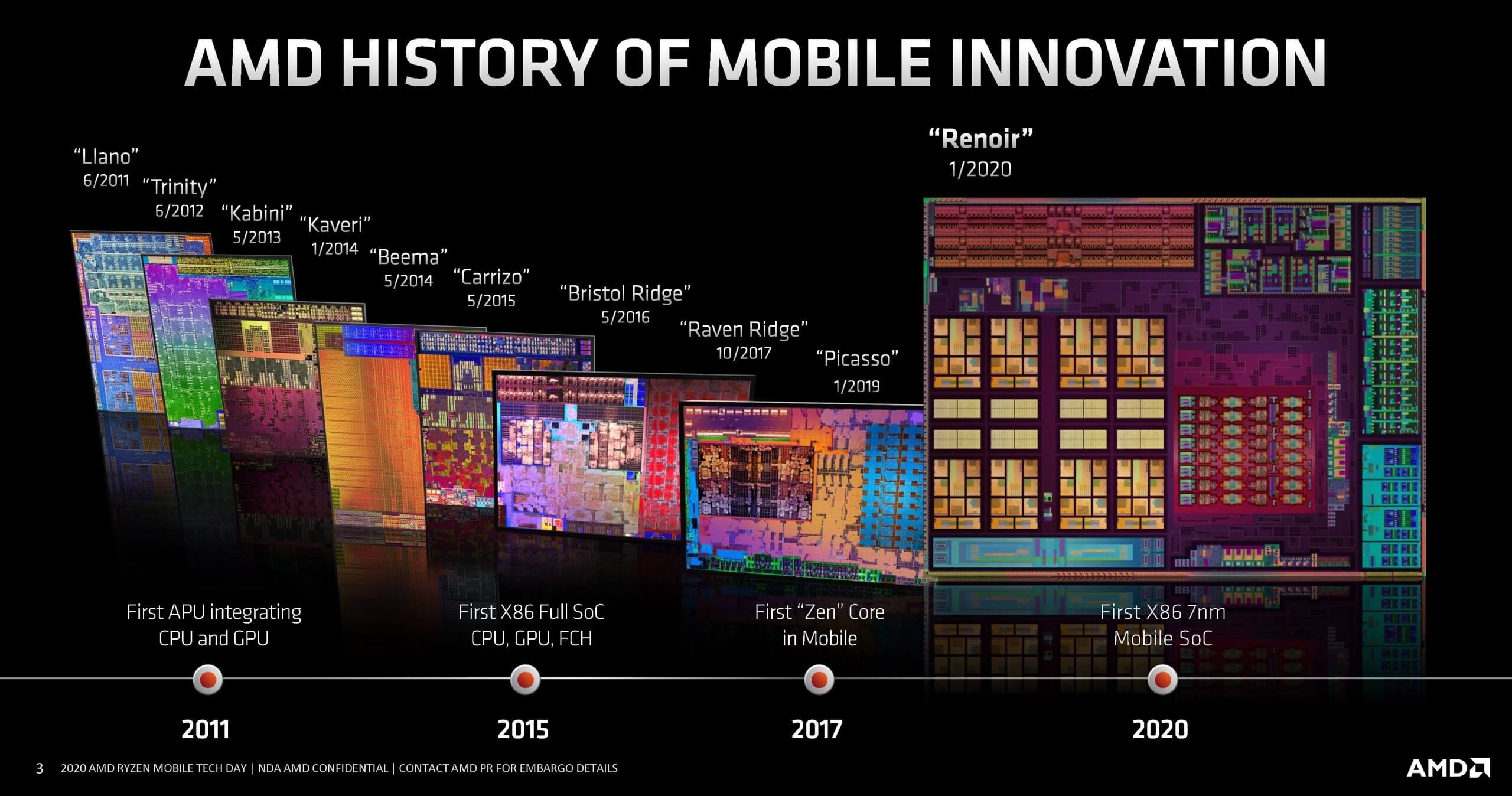Something to look forward to: Recently I spent a week in Austin visiting AMD's offices to go over all the key information about Ryzen 4000 APUs, that is, the upcoming CPUs that will power next-gen Ryzen laptops. Originally we were prepared to publish a full review with benchmarks of Ryzen Mobile 4000, however laptops that utilize the new chip have been delayed due to Coronavirus and all dates have been pushed back as a result. On the bright side, we think this is going to be an exciting launch that will push the laptop market forward in a significant way.
We'll be able to show you and discuss our own Ryzen Mobile benchmarks next month, but for now we can show you the data AMD presented at its Tech Day in February. One of the reasons we can share this information is that some Ryzen 4000 systems are going on sale – or at least will be available for pre-order – in some regions starting today. We've heard the Asus Zephyrus G14 equipped with H-series Ryzen processors is shipping right away, so hopefully we can show off some benchmarks using this system as soon as possible.
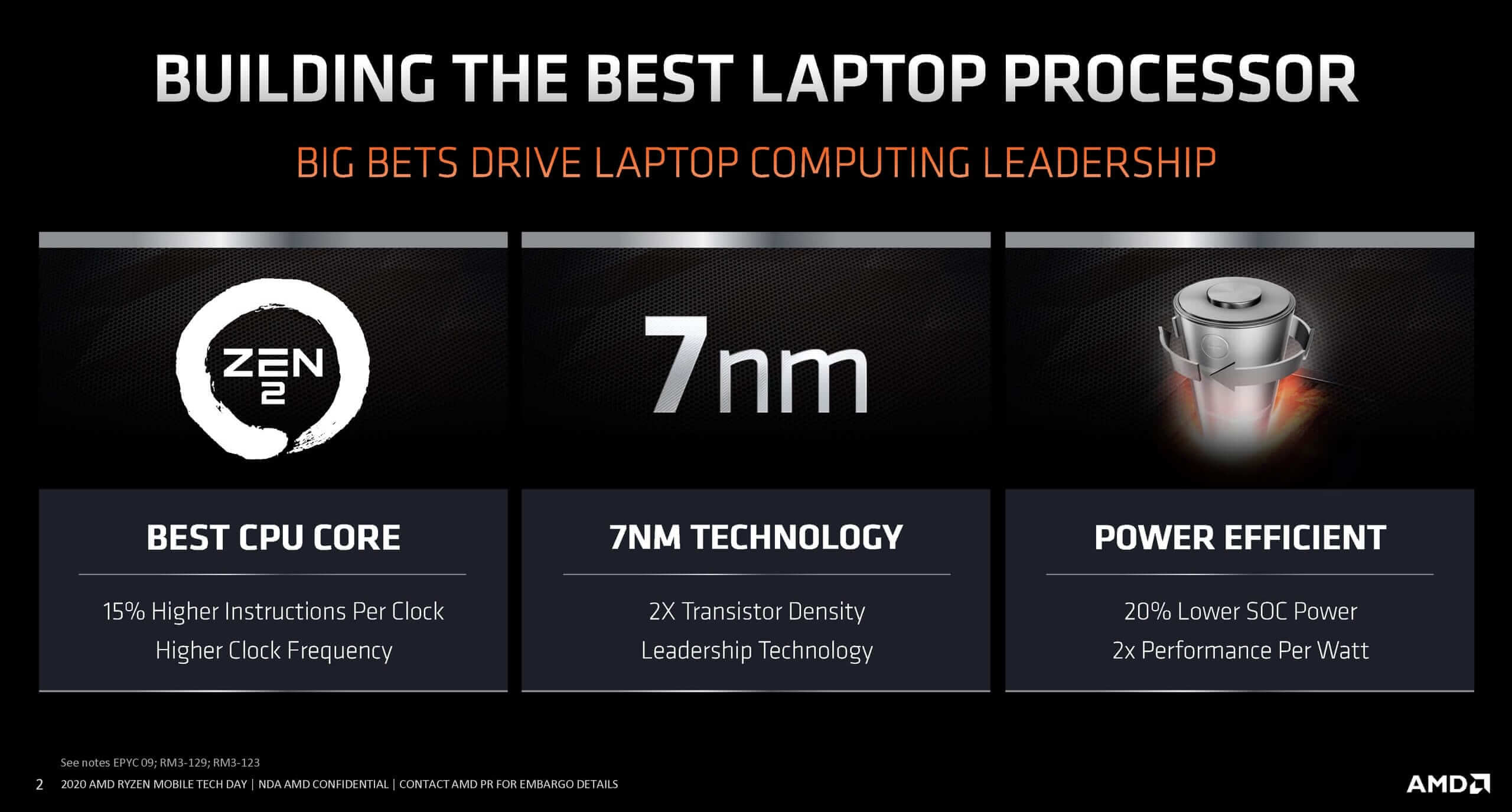
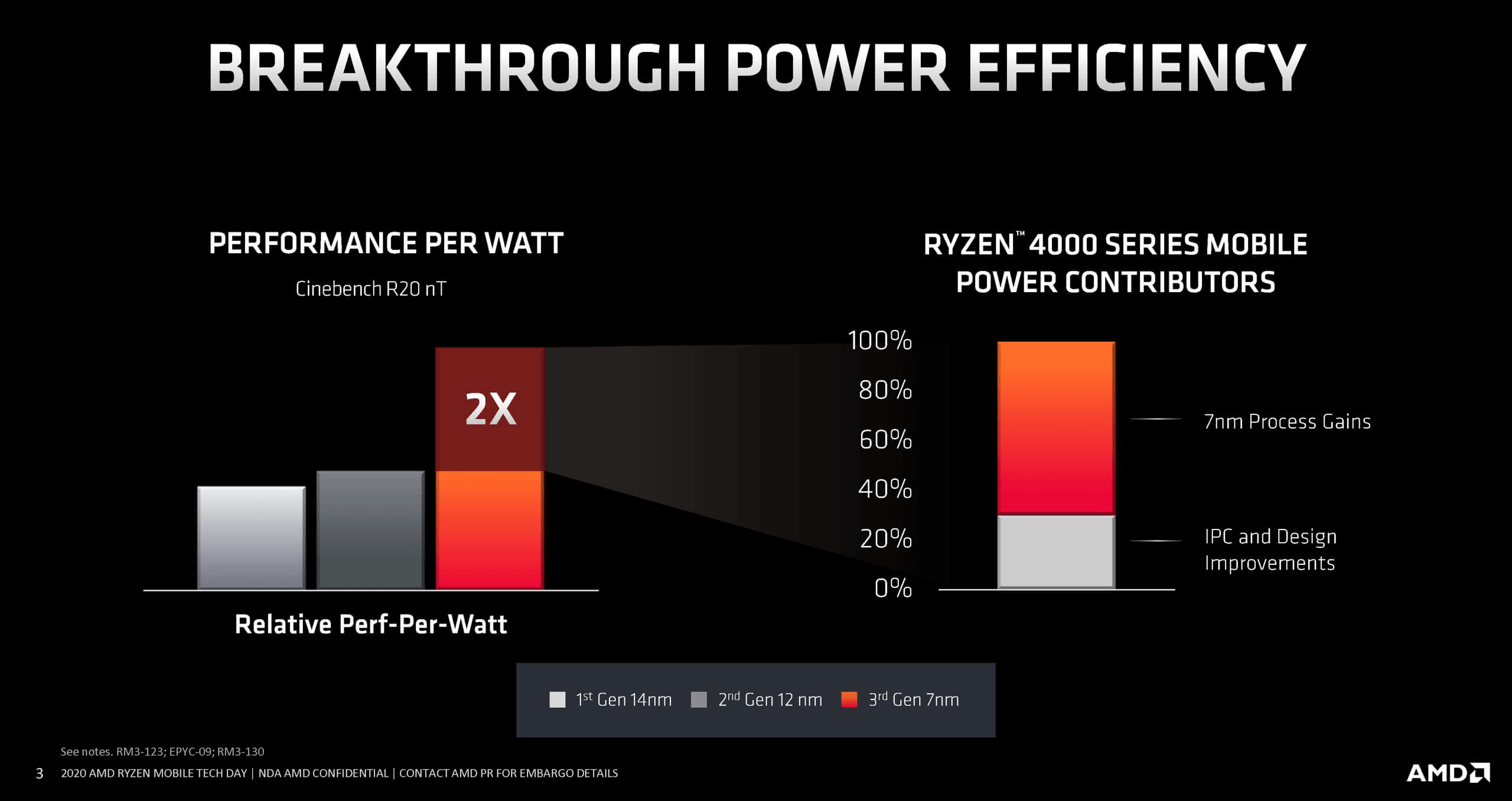
All Ryzen 4000 APUs are based on the Zen 2 architecture, built using 7nm technology with a monolithic die that also incorporates a Vega-based GPU. The 15W U-series includes five SKUs covering Ryzen 3 through Ryzen 7 with up to 8 cores and 16 threads in the highest-end part, with clock speeds topping out in the 4.2 GHz range under boost conditions. There's also a maximum of 8 graphics compute units on the die, with a significant clock speed bump up to 1750 MHz for the Ryzen 7 4800U... but we knew all of this from CES 2020.
AMD also revealed the Ryzen 4000 H-series, which at the time was announced to include two SKUs, the Ryzen 7 4800H as an 8-core part, and Ryzen 5 4600H as a 6-core part, both with 45W TDPs. AMD has added today several other SKUs in the line-up, most notably the Ryzen 9 4900H.
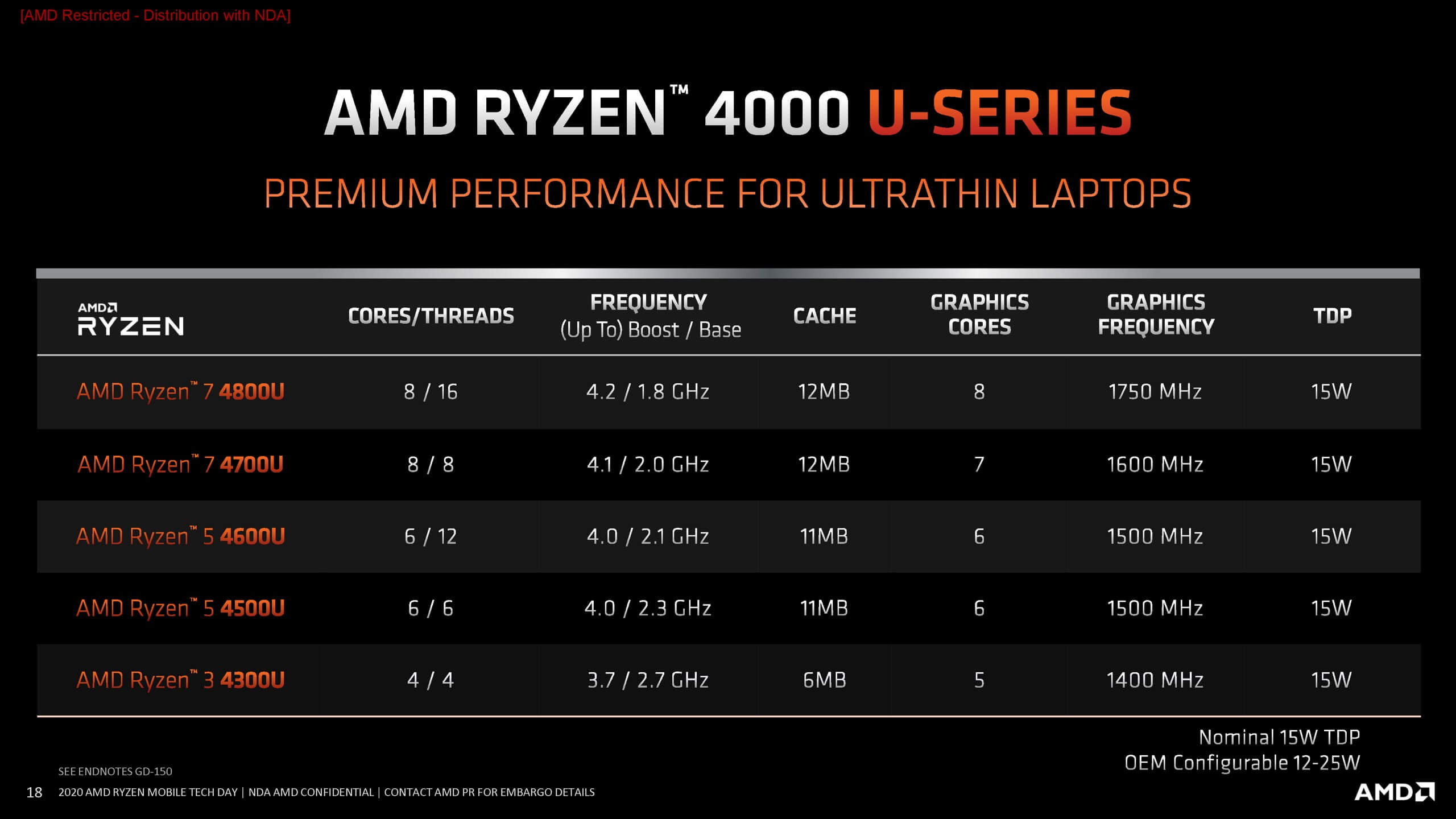
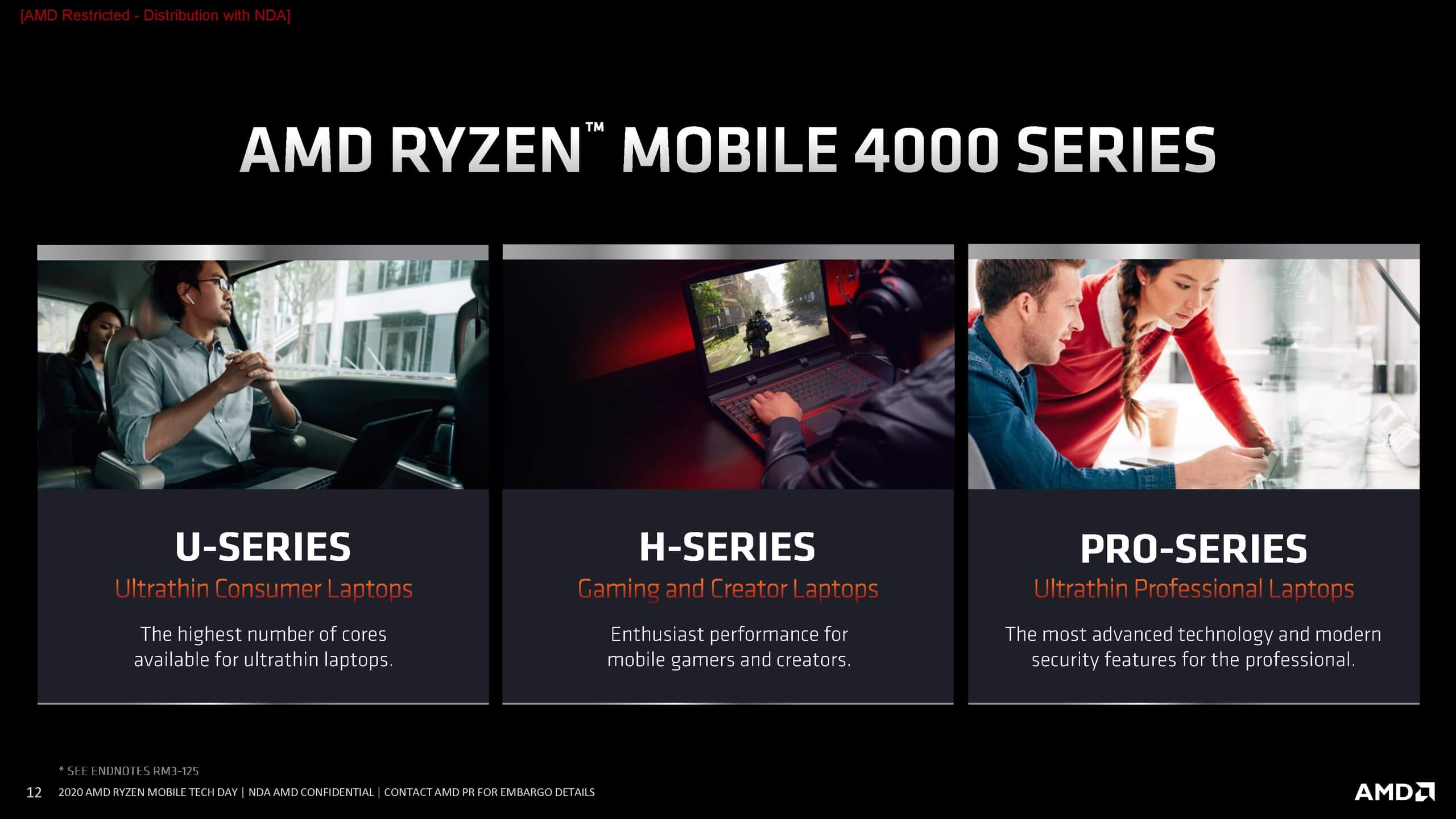
Basic core configuration of the Ryzen 9 4900H is the same as the Ryzen 7 4800H: it's an 8-core, 16-thread CPU with 12MB of L3 cache and a 45W TDP. However, it appears as though AMD is binning these CPUs aggressively to deliver extra performance for those that grab a Ryzen 9 system. The 4900H ups the boost frequency to 4.4 GHz, but crucially, the base frequency gets a substantial bump from 2.9 GHz to 3.3 GHz.
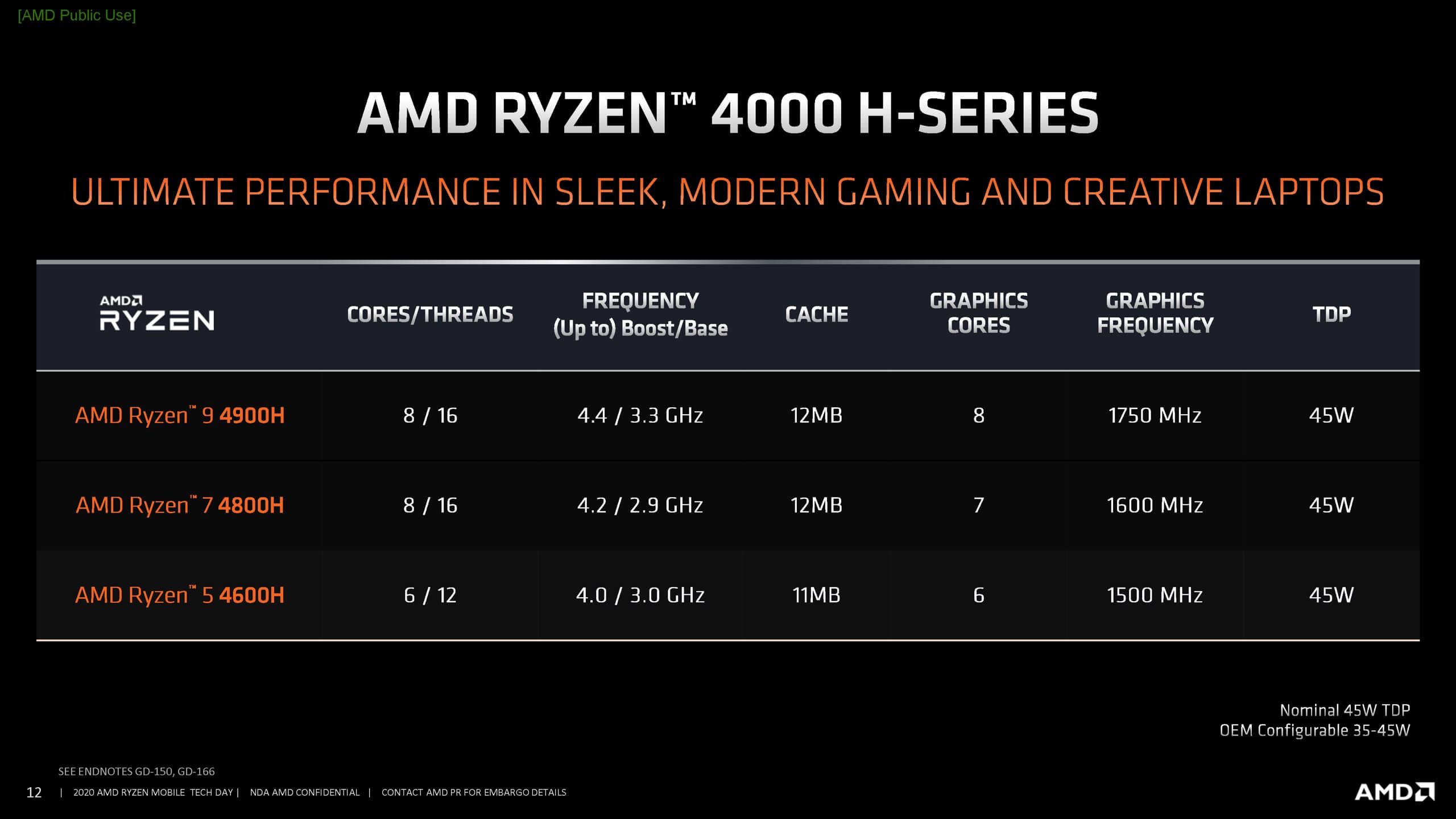
While these specs don't necessarily indicate the actual clock speeds the part will run at under sustained workloads – that figure tends to be a mystery with most mobile chips until you actually test them – this is still a substantial upgrade. This indicates that the 4900H will be able to clock itself higher and perform better within the same TDP limit, a likely result of binning, similar to what we saw with the Ryzen 9 3900X and 3950X on the desktop side: through chiplet binning, the 3950X is able to offer more cores and extra performance while consuming roughly the same amount of power as the 3900X.
The 4900H also brings an increase to GPU compute units, giving us the fully unlocked 8 cores with a 1750 MHz clock speed. This won't make a lot of difference to most H-series systems that will opt for discrete graphics instead, so the CPU improvements are the key here.
The Ryzen 9 4900H will be available in the spring of 2020 alongside the Ryzen 9 4900HS, a specially binned 35W version of the chip that features slightly lower clock speeds, but promises better efficiency. In fact, the 4900HS at 35W is clocked higher than the 4800H at 45W. As AMD already announced, there will also be a Ryzen 7 4800HS at 35W, which will be used in laptops like the Zephyrus G14.
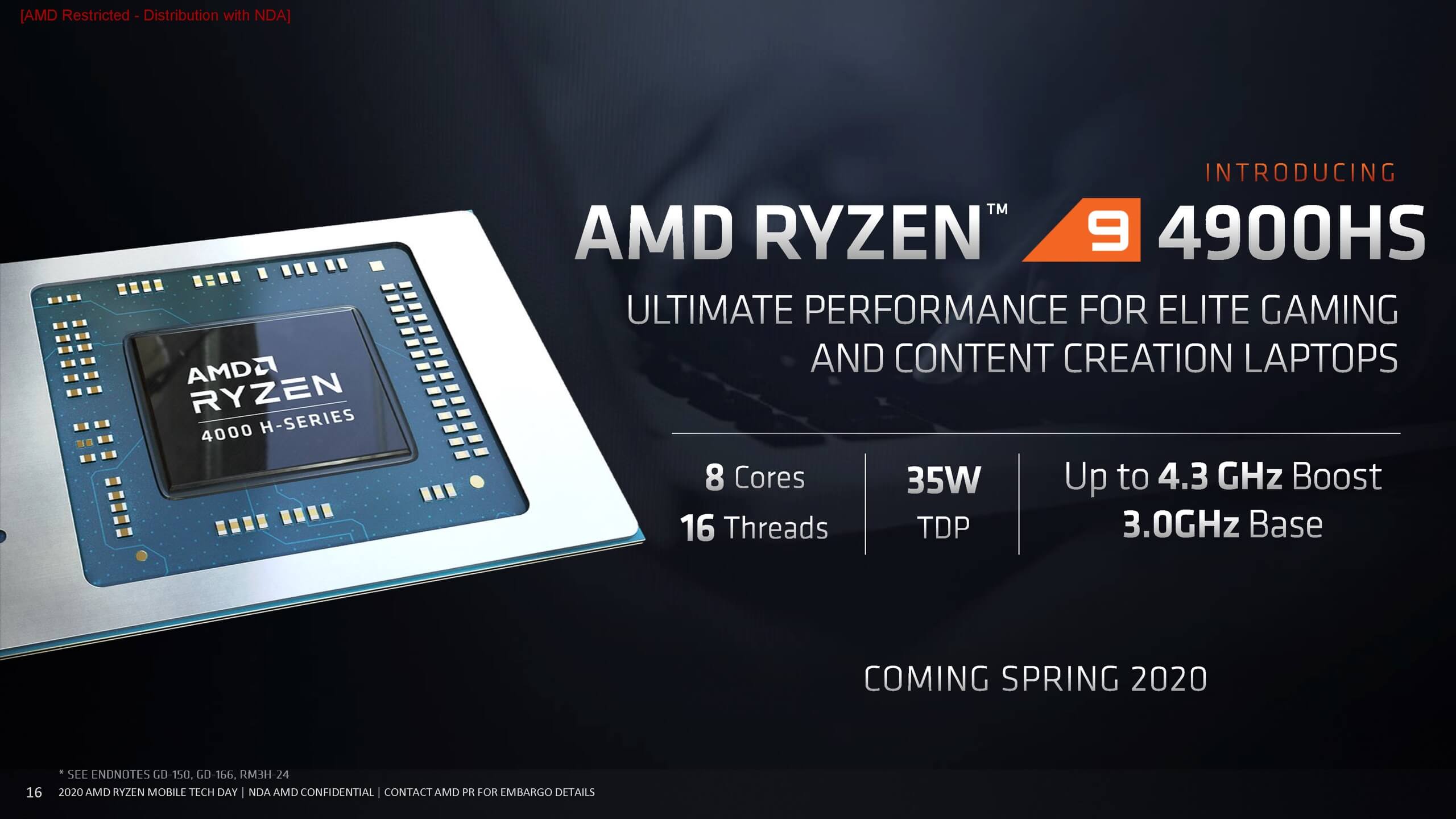
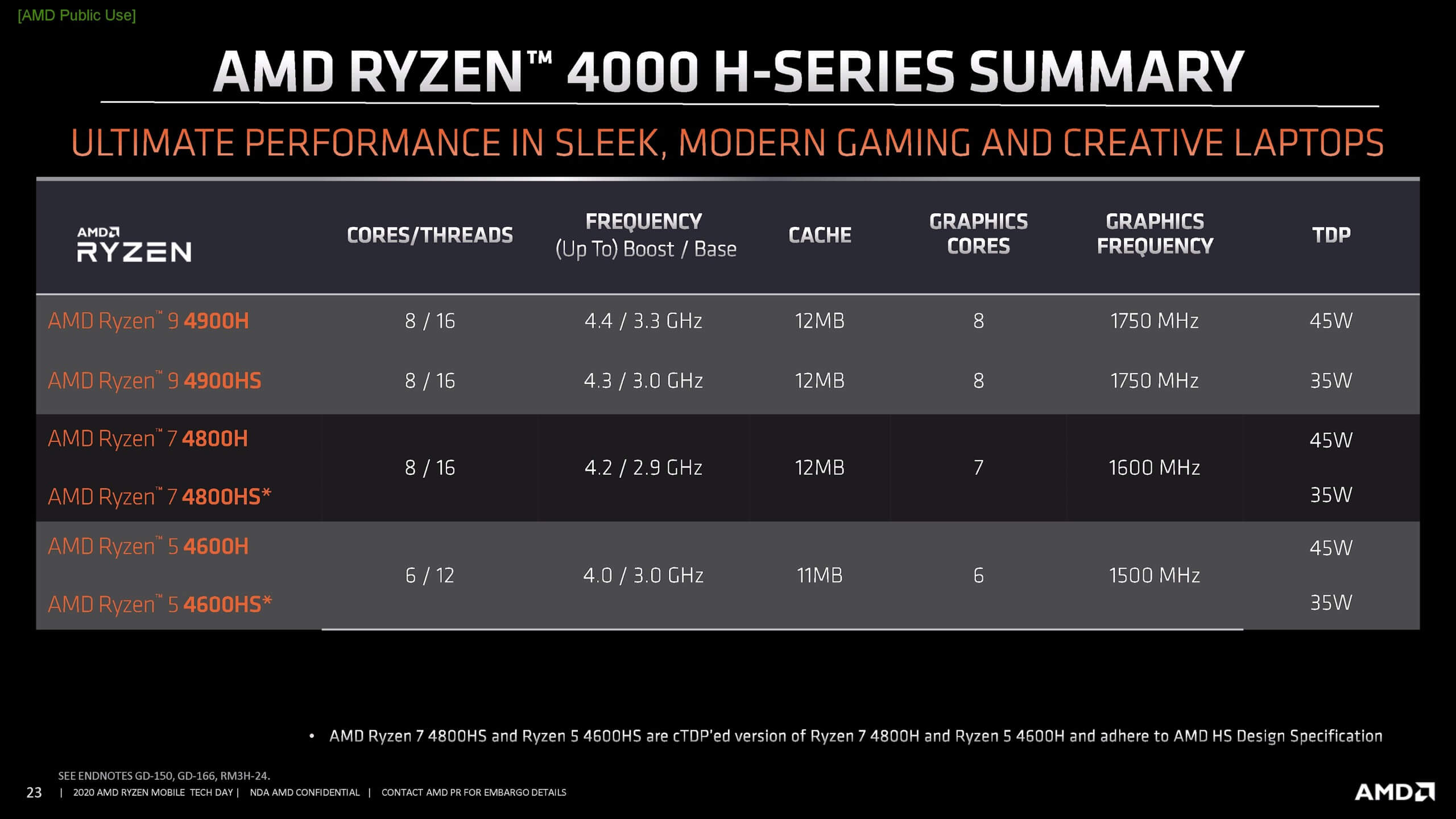
AMD was keen to emphasize that HS series isn't just about getting more efficient CPUs though. For an OEM to have access to these chips, they'll have to closely work with AMD on the design and validation of the system, and use other highly efficient components in the system. This will include power efficient displays, high-performance, low power memory, top-tier SSDs among other things. The idea is that if you are buying a laptop with an HS-series CPU, it's the best of what AMD has to offer in laptop form.
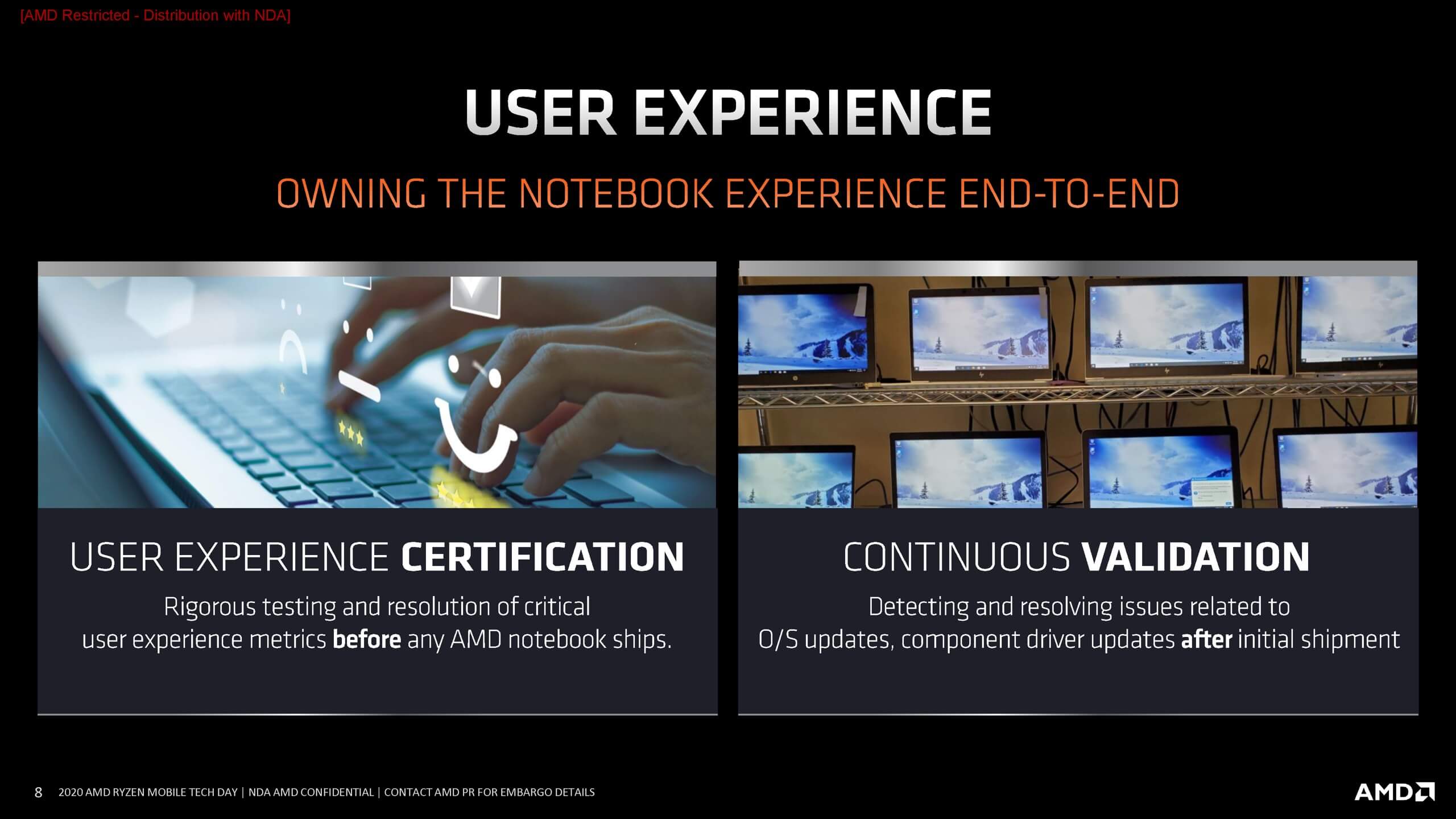
U-series buyers aren't getting left out either. While there are no S chips in the U-series, AMD is also working more closely with their partners to ensure OEMs aren't just pumping out garbage laptops like has been the case in the past. Part of this is once again, validating key components like the display, SSD and memory to ensure that high-quality stuff is used by OEMs. AMD also discussed validation after sale, to ensure the driver experience remains rock solid for owners over the lifespan of the system. We'll see how that plays out, but it's the biggest commitment AMD has made in the mobile space in a long time.
Performance Preview
Let's look at some of AMD's performance numbers. Do note, these are AMD's tests so take them with a grain of salt until we can provide our own performance data. Throughout the charts you're about to see, AMD has used reference systems with these APUs installed, rather than actual retail units, of course because retail units aren't available yet. Just keep that in mind.
Here are AMD's Cinebench results for the Ryzen 7 4800U and 4700U. The 4800U is the 8-core 16-thread model, while the 4700U is 8 cores and 8 threads. The 4800U undoubtedly looks impressive, offering 90% more multi-thread performance than the Ice Lake Core i7-1065G7 and 37% more than the six-core Comet Lake Core i7-10710U.
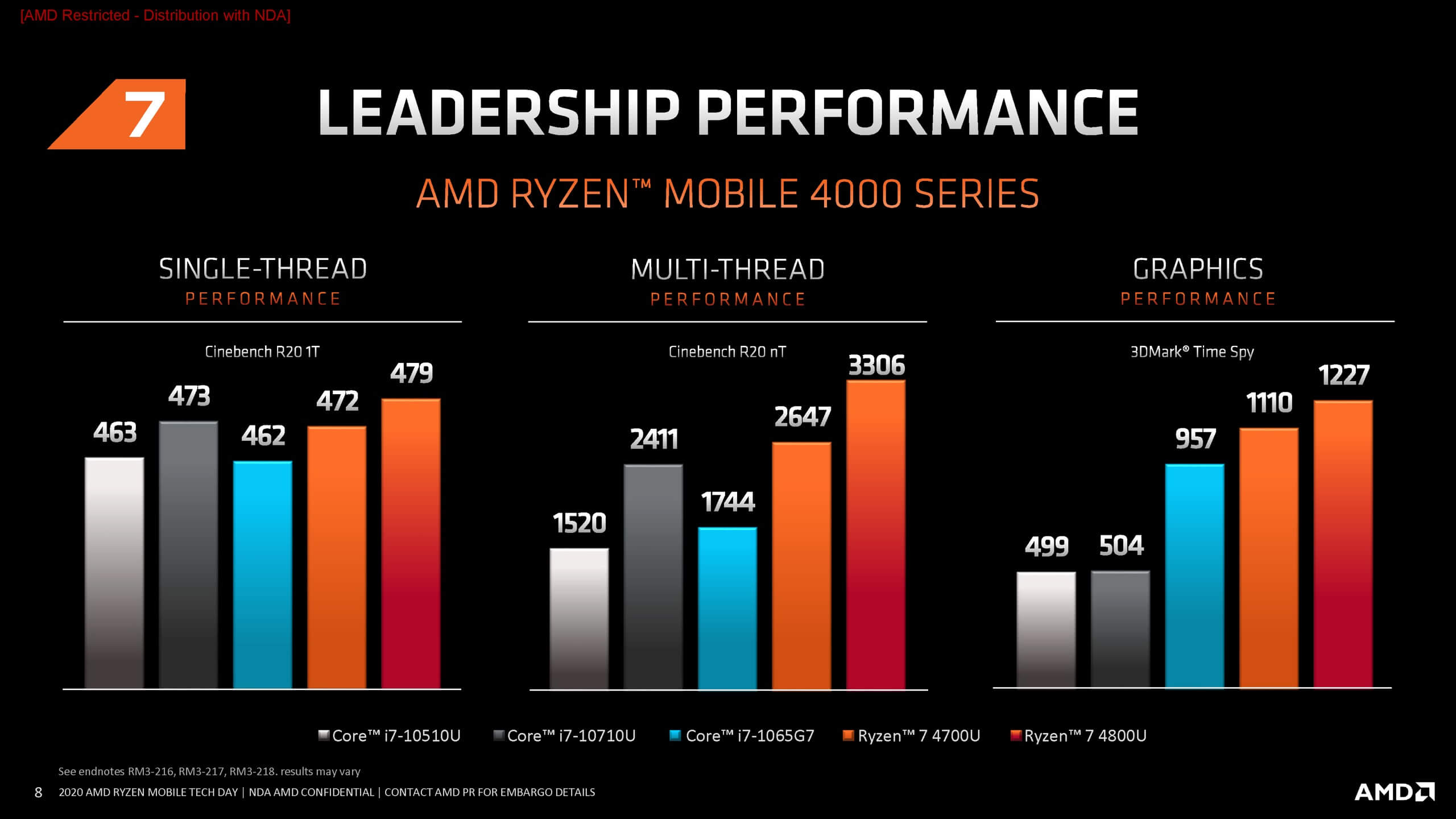
However that's not the whole story. AMD has used Dell XPS 13 test systems across all of these benchmarks, and the XPS 13 is well known to be configured to use a 25W power limit, rather than the default 15W these chips normally ship with. Meanwhile, AMD's reference platform is locked to 15W long term. Of course, both CPUs also have boost behaviour but the configured TDPs are different: 25W for Intel, 15W for AMD.
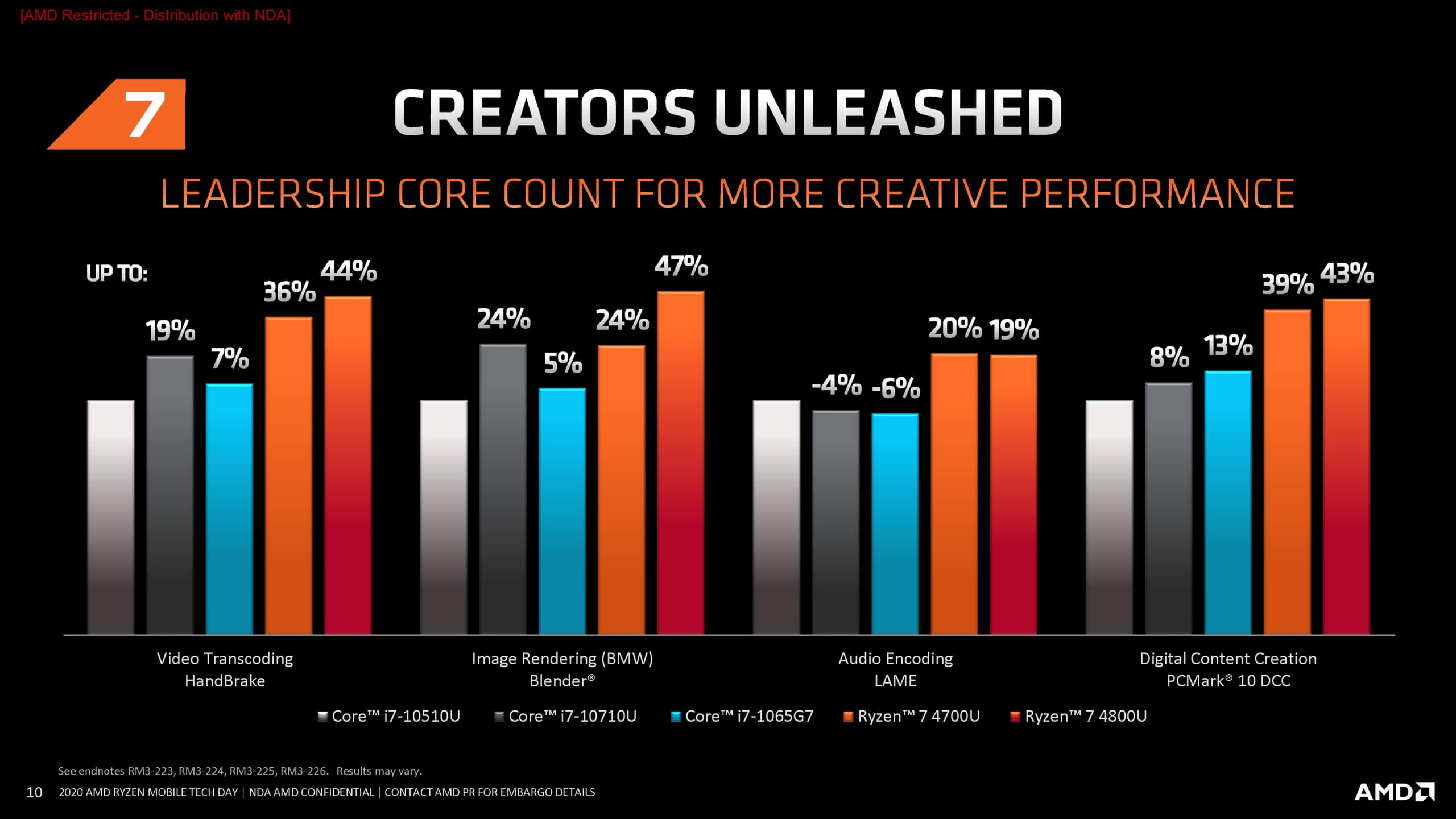
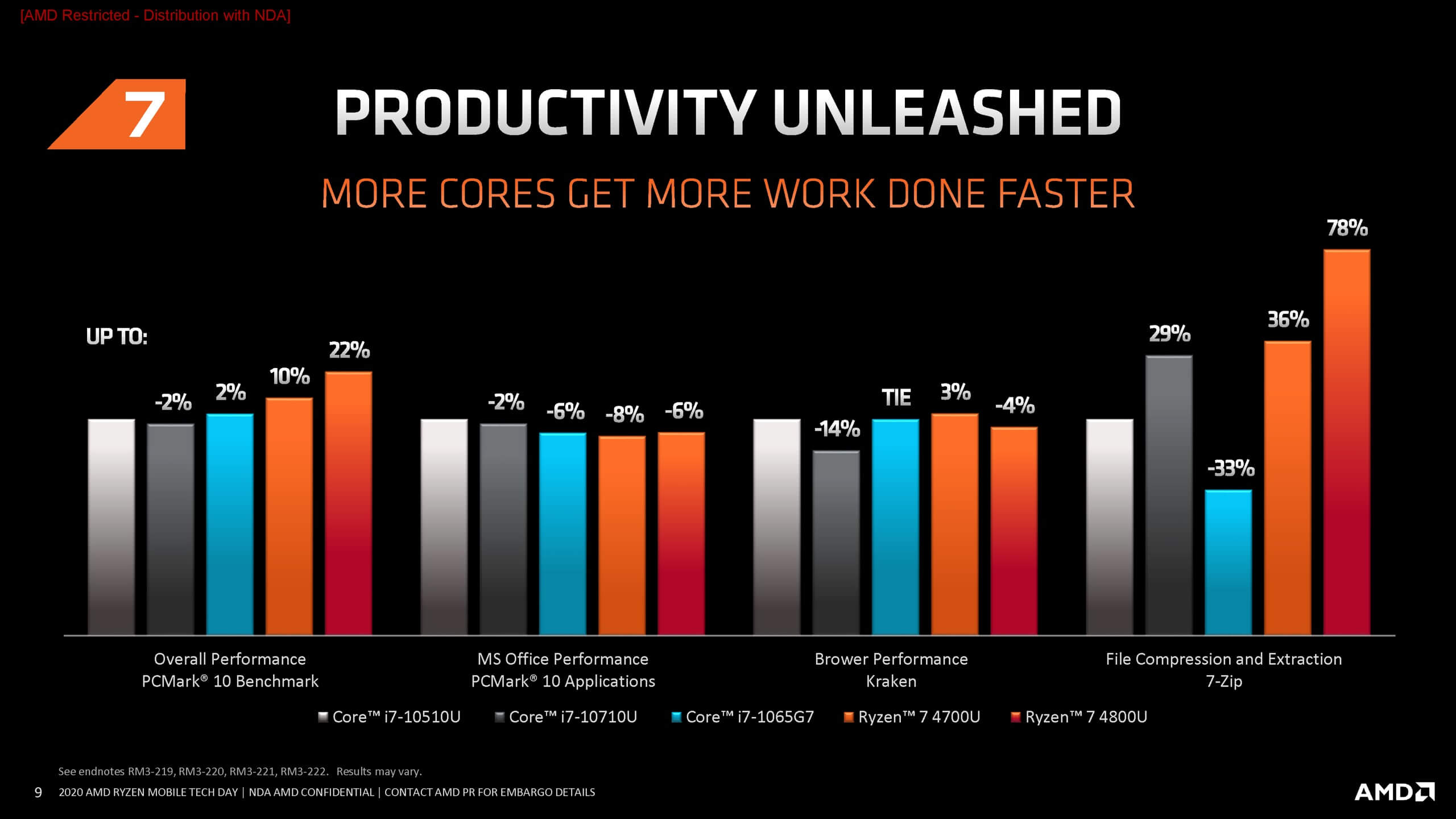
We spotted this because the numbers for the various Intel CPUs shown are closer to what we see in our own testing from 25W configurations. Scores at 15W are much lower. For example, the Razer Blade Stealth with a Core i7-1065G7 only scores 1,168 points in the multi-threaded test at 15W, and for the 10710U we usually see scores around 1,500 at 15W.
We'll have to dive into this further when we get hands-on time with actual Ryzen 4000 U-series laptops, but at face value it looks like AMD's 8-core chips could be twice as fast as Intel's best 6-core offering when both systems are configured to the same TDP.
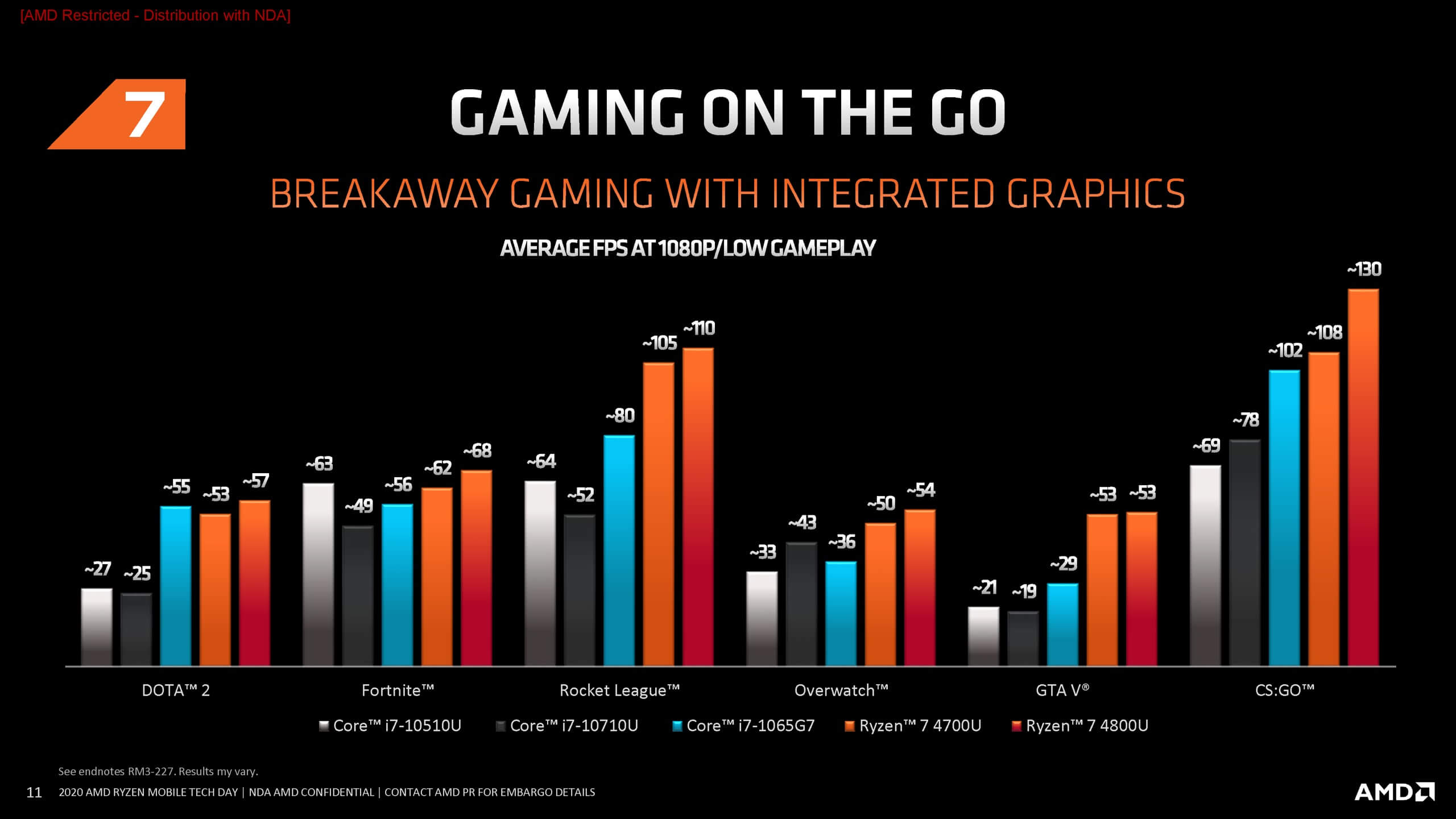
Graphics performance has the Ryzen 7 4800U about 28% percent ahead of Intel's Ice Lake in 3DMark Time Spy, but again, this is with the 1065G7 configured to 25W. Our 15W numbers would put the 4800U more like twice as fast.
AMD also shared a ton more performance breakdowns with the Ryzen 7 series up against Core i7, most of which favor the AMD processor in one way or another. In some circumstances the chip isn't faster, like with PCMark 10's Office application benchmark, but most of the time and especially for creator workloads, the difference is substantial – again, according to AMD.
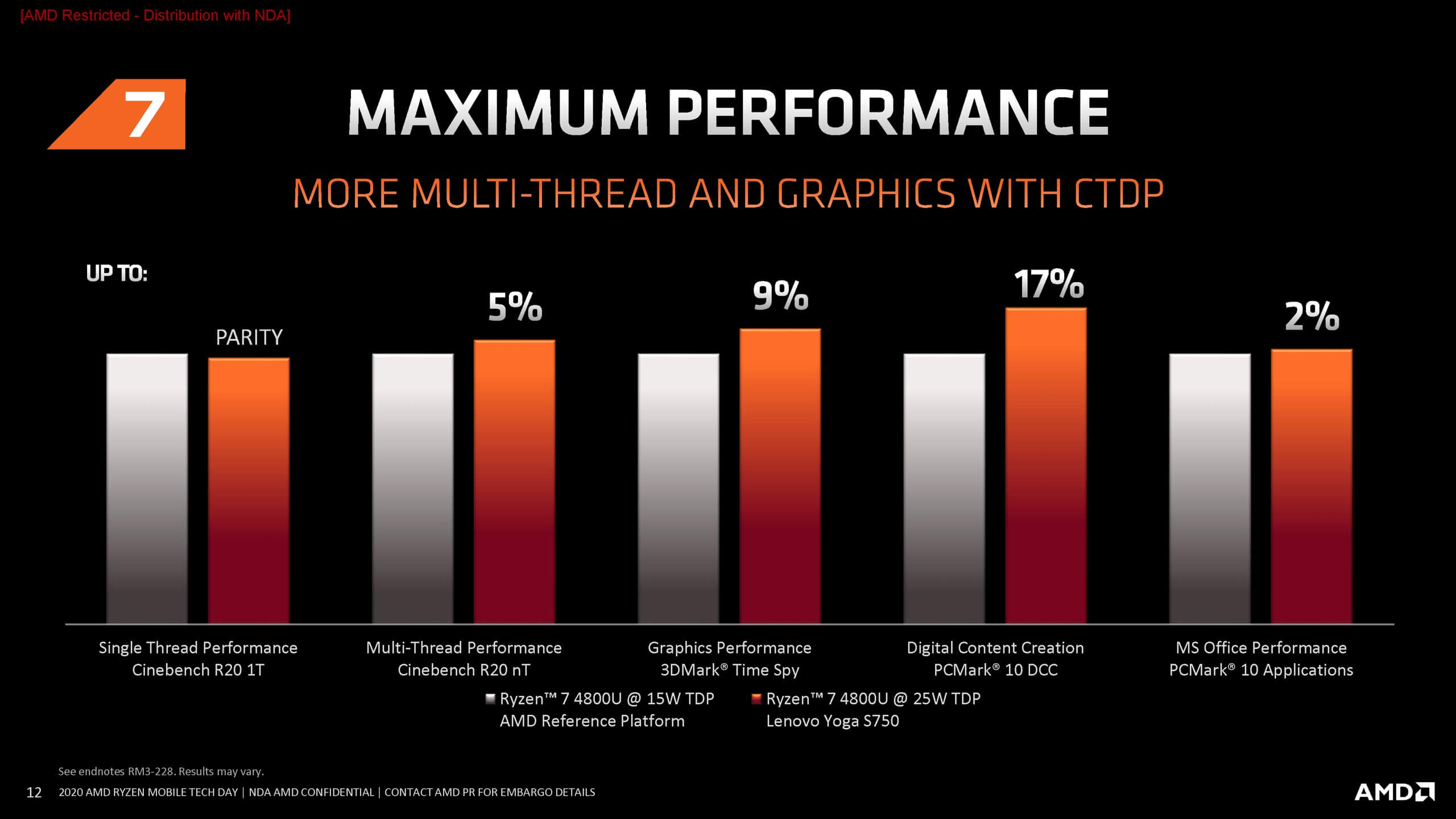
Here are some gaming numbers for the Ryzen 4000 series, showing very solid performance at 1080p with low settings, often significantly outperforming Ice Lake depending on the title. And here's the difference between AMD's 15W and 25W configurations, although I suspect the numbers here are a bit on the conservative side.
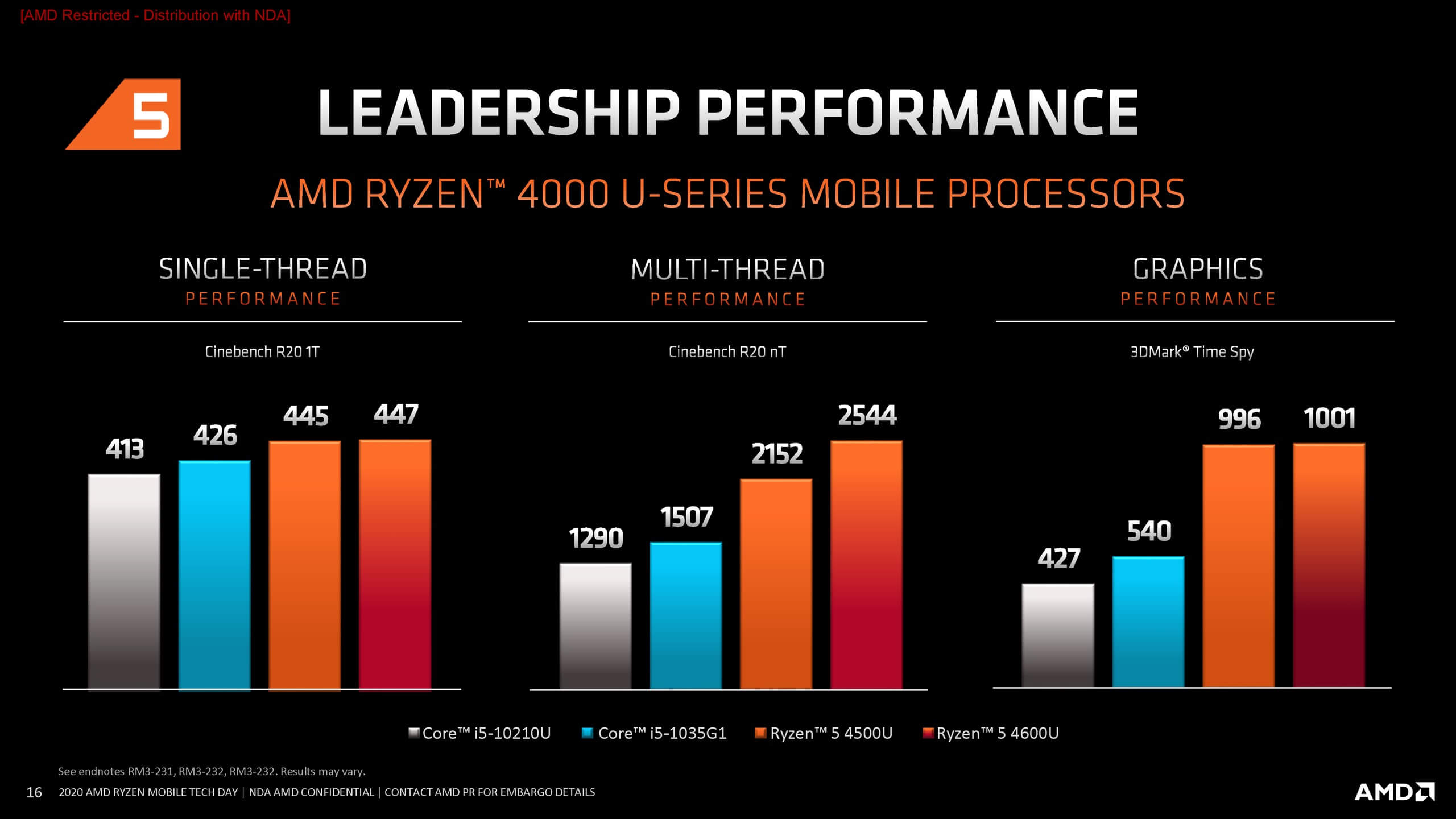
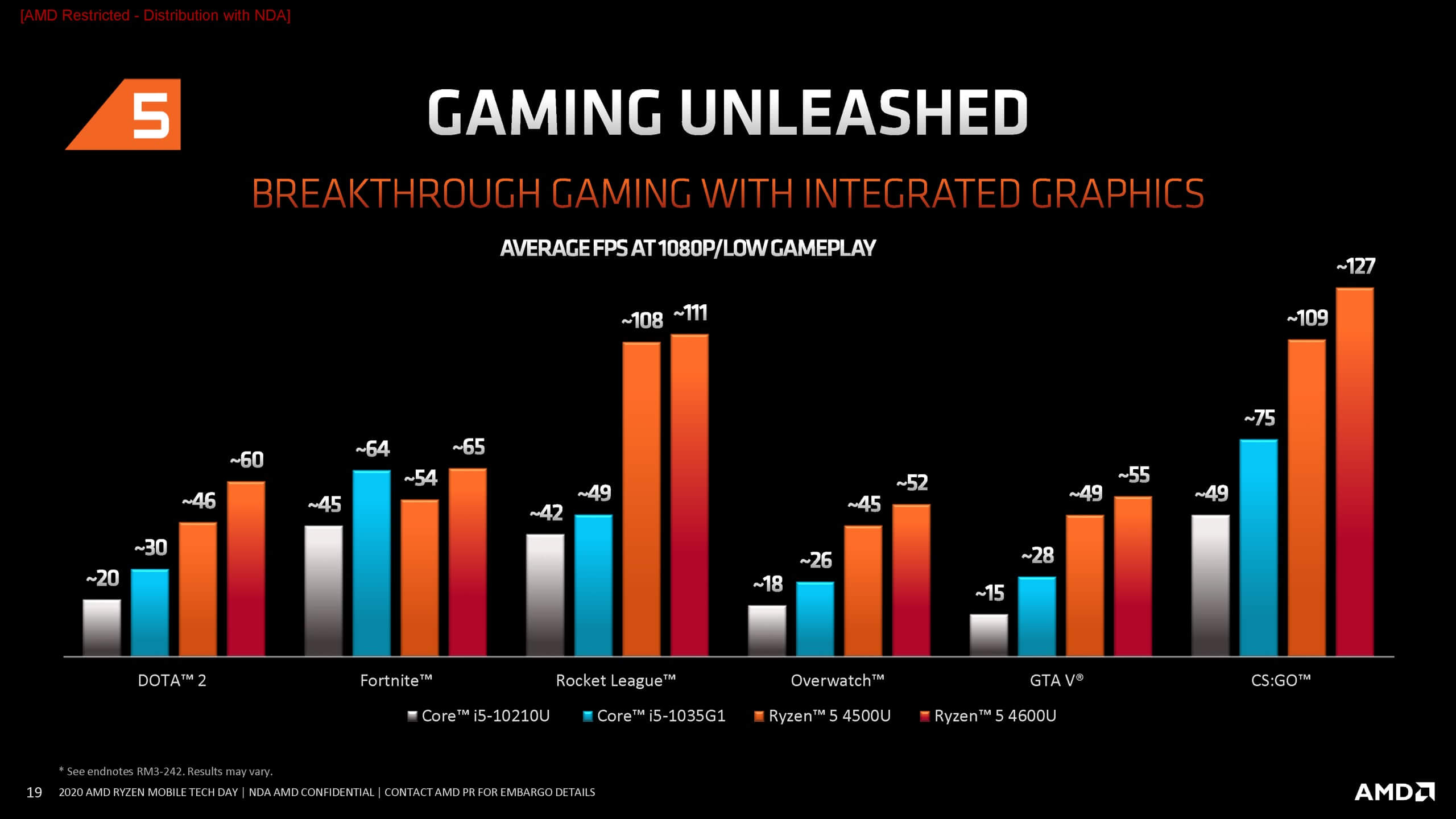
AMD also showed off Ryzen 5 U-series performance, once again showing a substantial performance lead over the competition. Here we're looking at an AMD six-core part up against Intel quad-cores and the core difference, plus the advantages of 7nm efficiency, deliver huge gains for AMD in this segment.
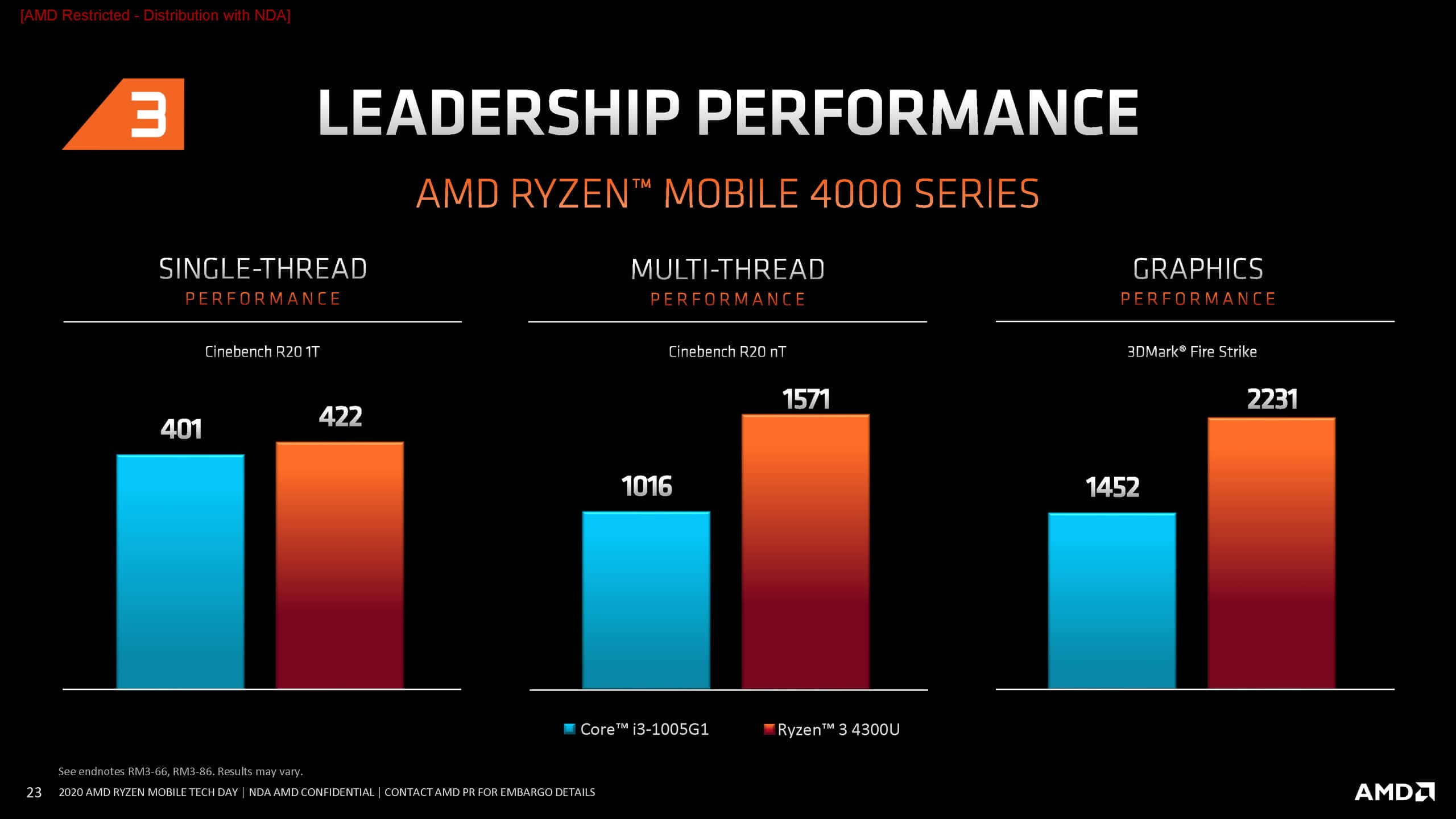
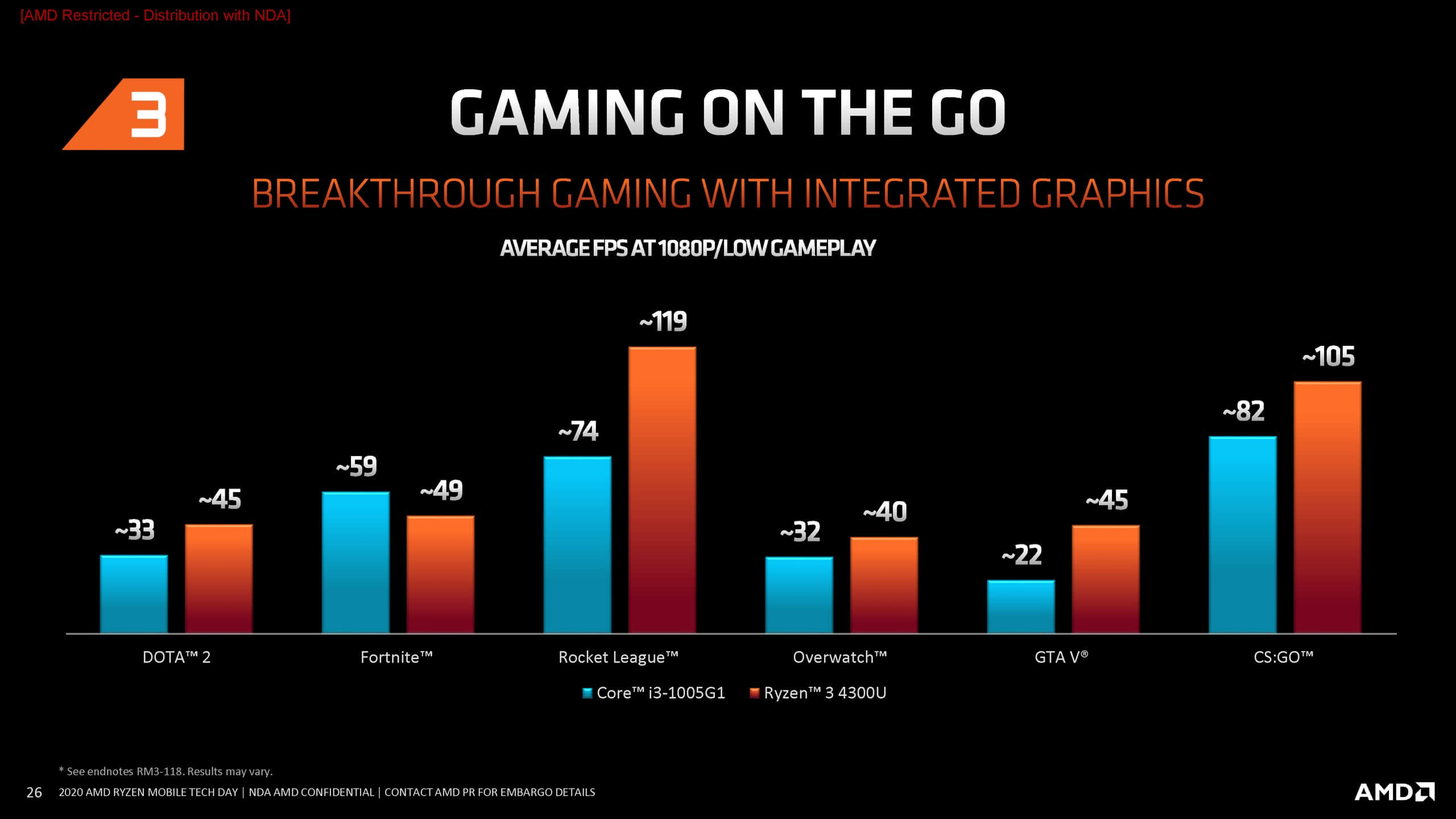
We also have some limited numbers for the Ryzen 3 series. AMD is only offering a quad-core chip but that's still a decent improvement over Intel's Core i3 Ice Lake.
AMD didn't have as much information on H-series performance, although we did see some numbers for a few of the chips. In Cinebench R20, AMD expects the Ryzen 7 4800H to outperform both the Core i7-9750H and Core i9-9980H. Of course, 10th-gen parts are coming soon from Intel in the H-series, but we don't expect performance to improve significantly over what is already available. Notably, AMD didn't compare the 4800H to the Core i9-9980HK which is Intel's higher-clocked flagship 45W CPU, although that chip is typically found only in massive laptops or otherwise it throttles hard.
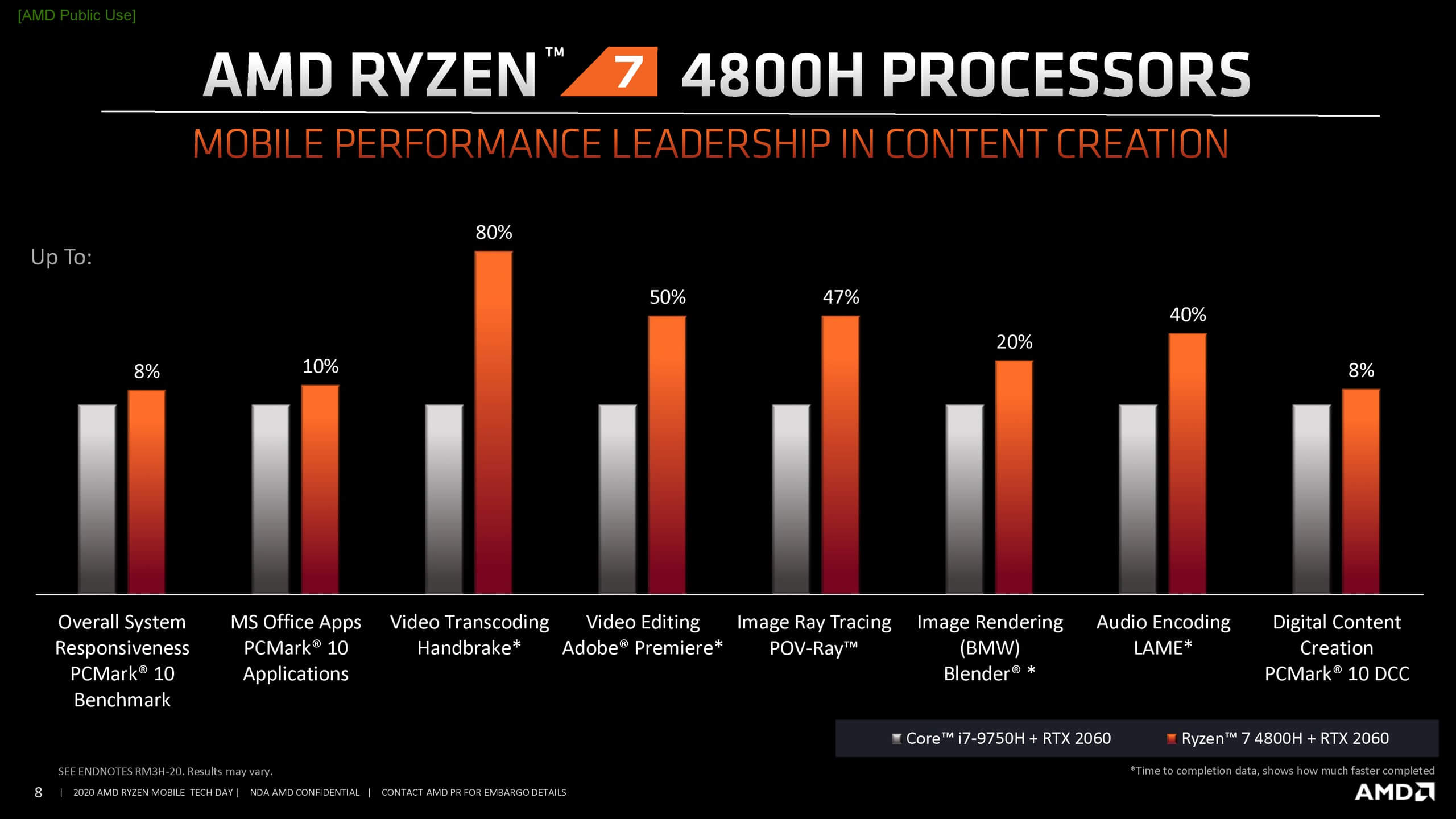
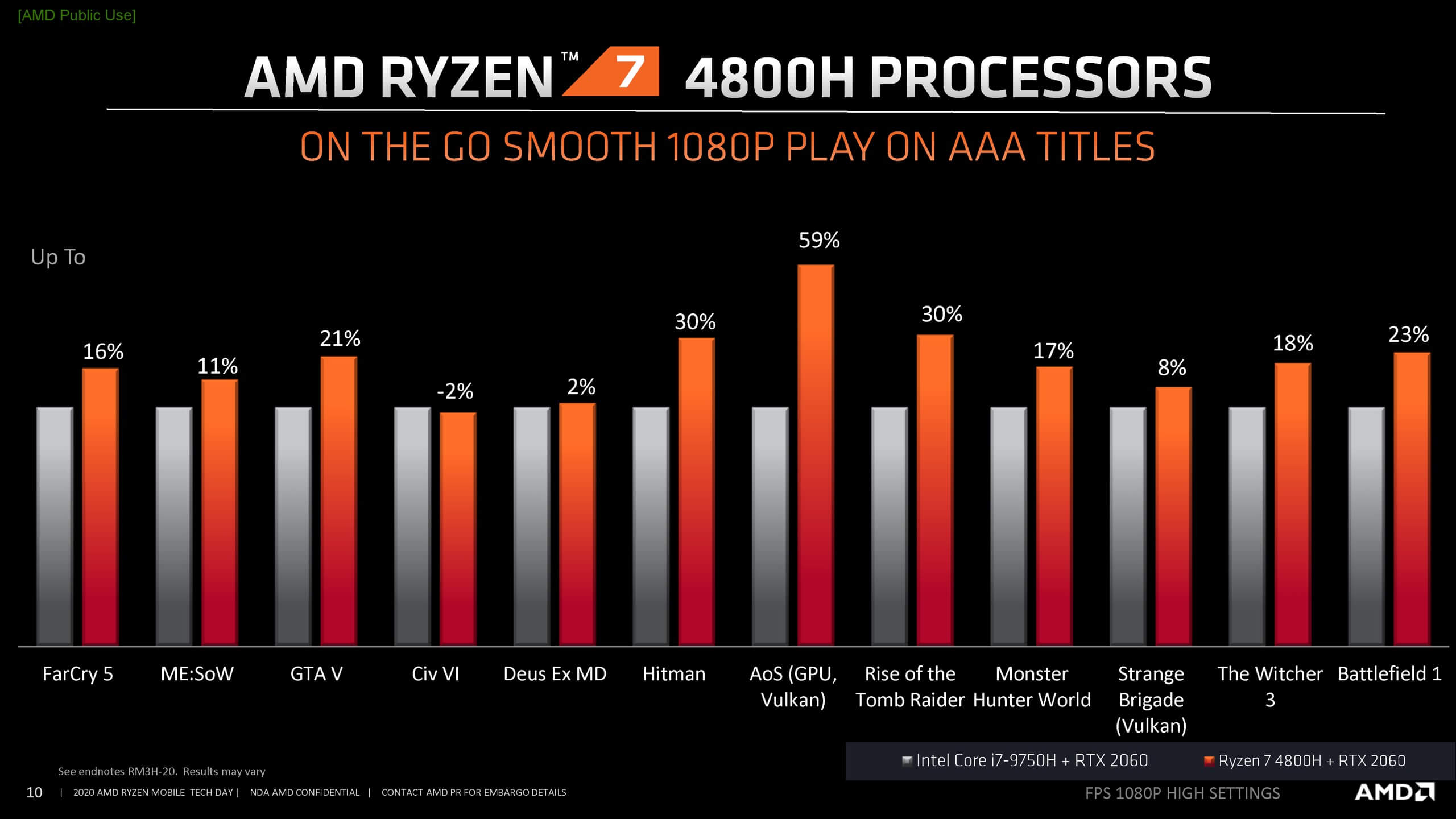
Most of AMD's other comparisons focused on 4800H vs 9750H, where predictably with two extra cores the AMD part goes on to dominate. Both systems have the same discrete GPU in Nvidia's RTX 2060. AMD is also suggesting that with a GPU like the RTX 2060, gaming performance will be higher with a Ryzen 7 4800H over the Core i7-9750H, sometimes significantly depending on how CPU limited the game is at 1080p.
And finally we did get some Ryzen 9 4900HS numbers comparing this CPU to the Core i9-9980H. AMD's CPU does very well at 35W up against the 9980H at 45W, going by AMD's own tests for now.
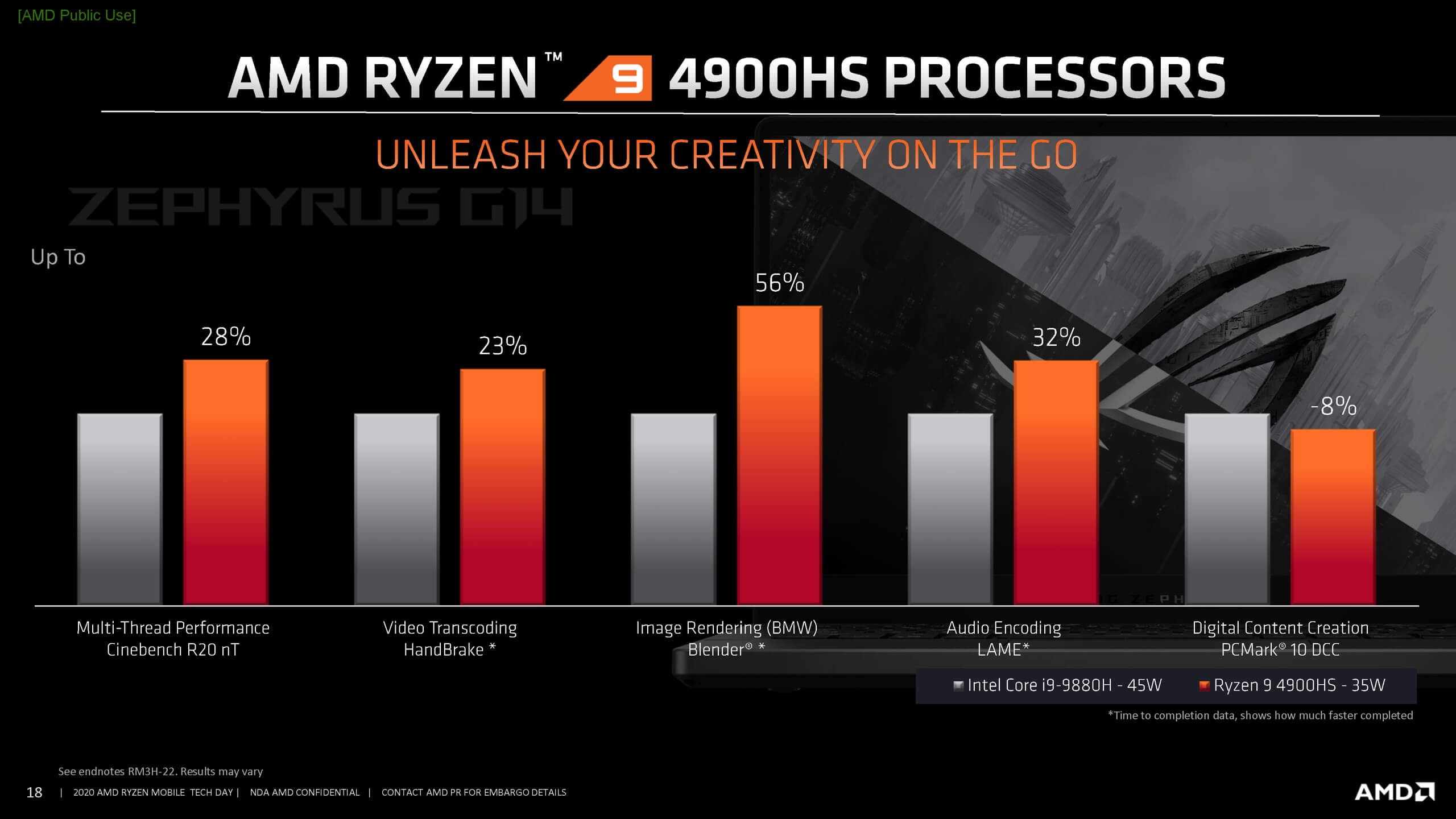
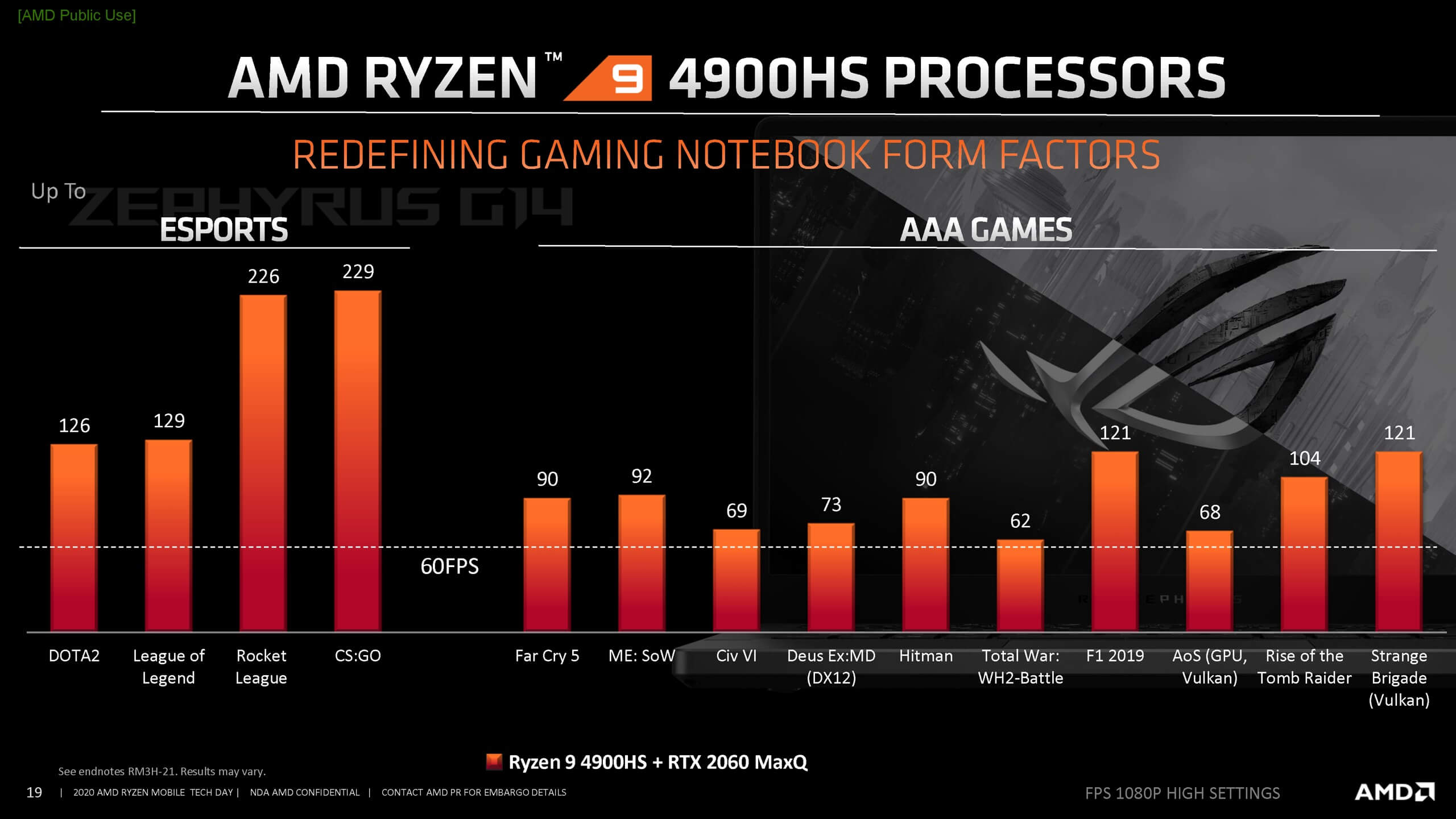
Integrated graphics, architectural improvements, and more
With all the performance stuff out of the way, let's dive into some of the architectural improvements AMD has made with Ryzen 4000. There are some cool additions that caught my eye. First, there's been a lot of discussion around the GPU being Vega rather than AMD's newer Navi design based on RDNA. However, AMD have made significant updates to the Vega core for Ryzen 4000 APUs that allows it to deliver up to 59% more performance per compute unit. You can see some of the improvements here, but the big ones include some architectural changes targeting efficiency, as well as higher clocks and more memory bandwidth.
While this new design does allow for 59% higher performance per CU, there is a reduction in total CUs from 11 down to 8. When you crunch the numbers and extrapolate a bit, this means AMD are expecting around 16% higher graphics performance overall comparing 8 of these new CUs to 11 last-gen CUs. However we don't know what real world performance gains will look like until we do some benchmarking, and we suspect the memory bandwidth improvements will be huge there.
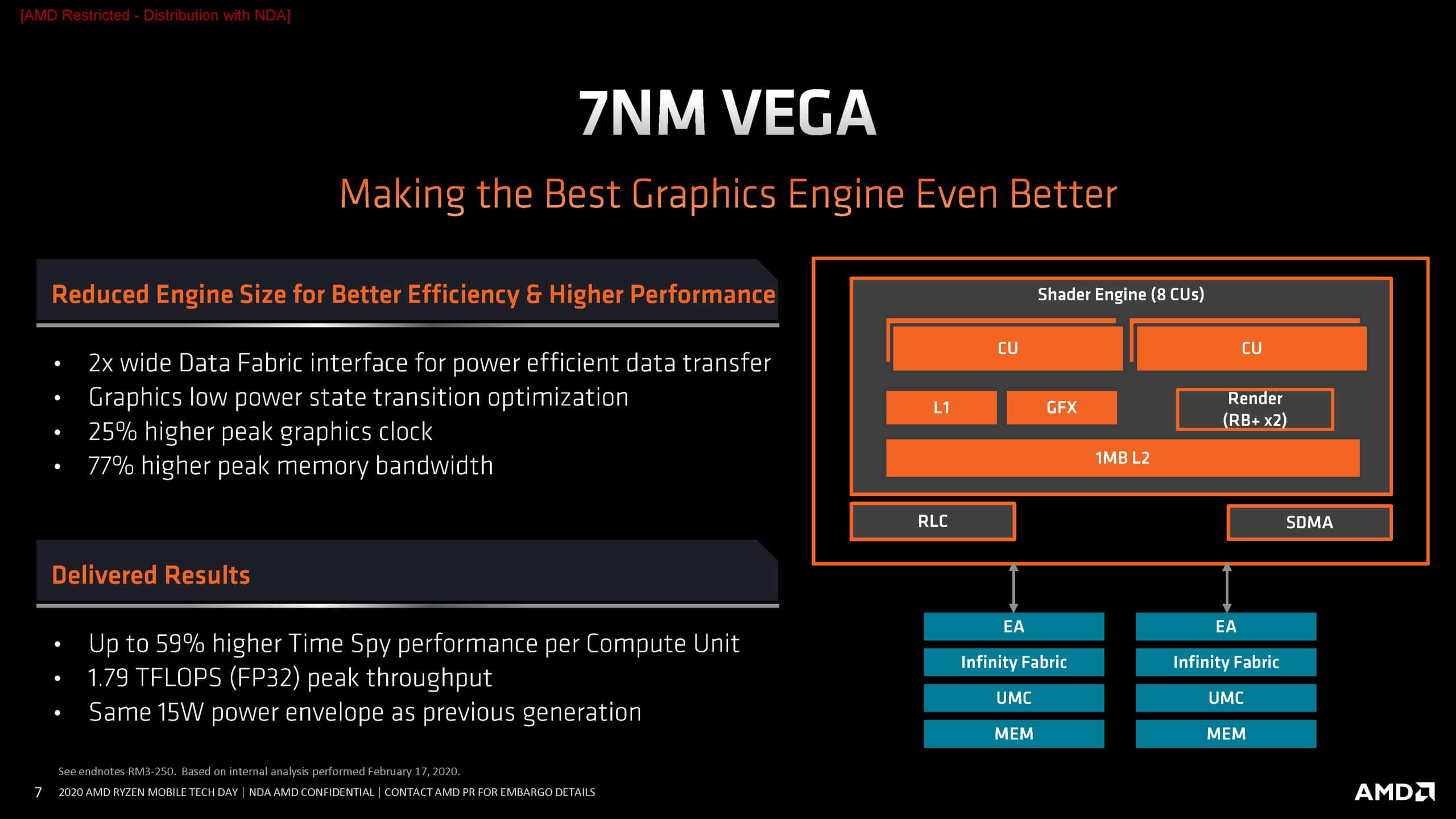
The memory system is improved in Ryzen Mobile. We are getting support for up to DDR4-3200 or LPDDR4X-4266. This matches Intel's Ice Lake on the DDR4 side, while offering even higher performance in the LPPDR4X route, noting that Ice Lake tops out at 3733 support.
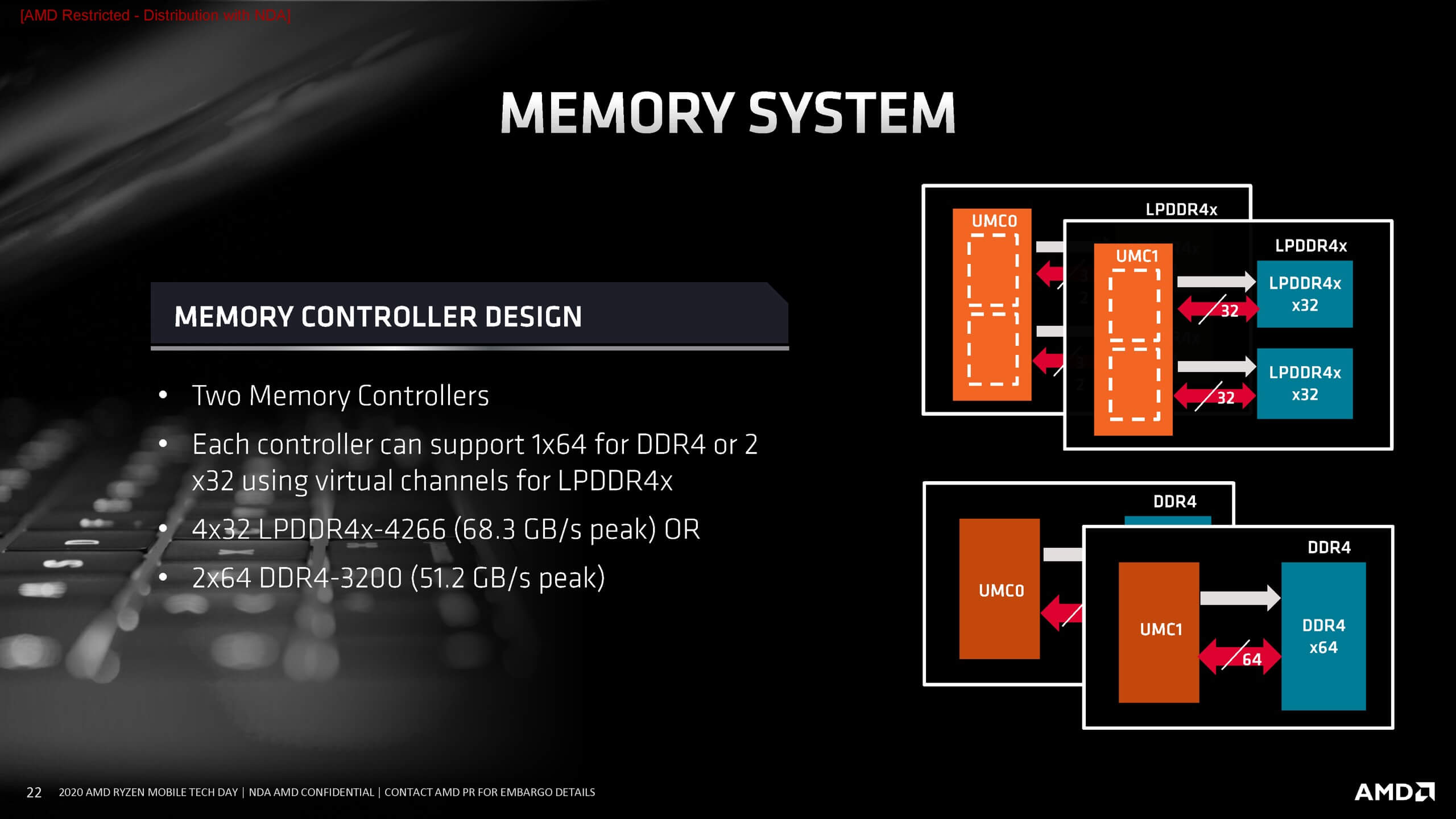
But even better news for this APU is how it will split memory between the CPU and GPU. In previous generations this was fixed and often set by the OEM to something like 512MB or 1GB. With Renior, this frame buffer allocation is now dynamic: if the GPU needs more VRAM, it can allocate more memory to the GPU. And when the CPU is primarily being used, it can ramp down the GPU allocation significantly. This will help a lot with 8GB systems that were often limited to just 6GB of usable memory with Ryzen 3000.
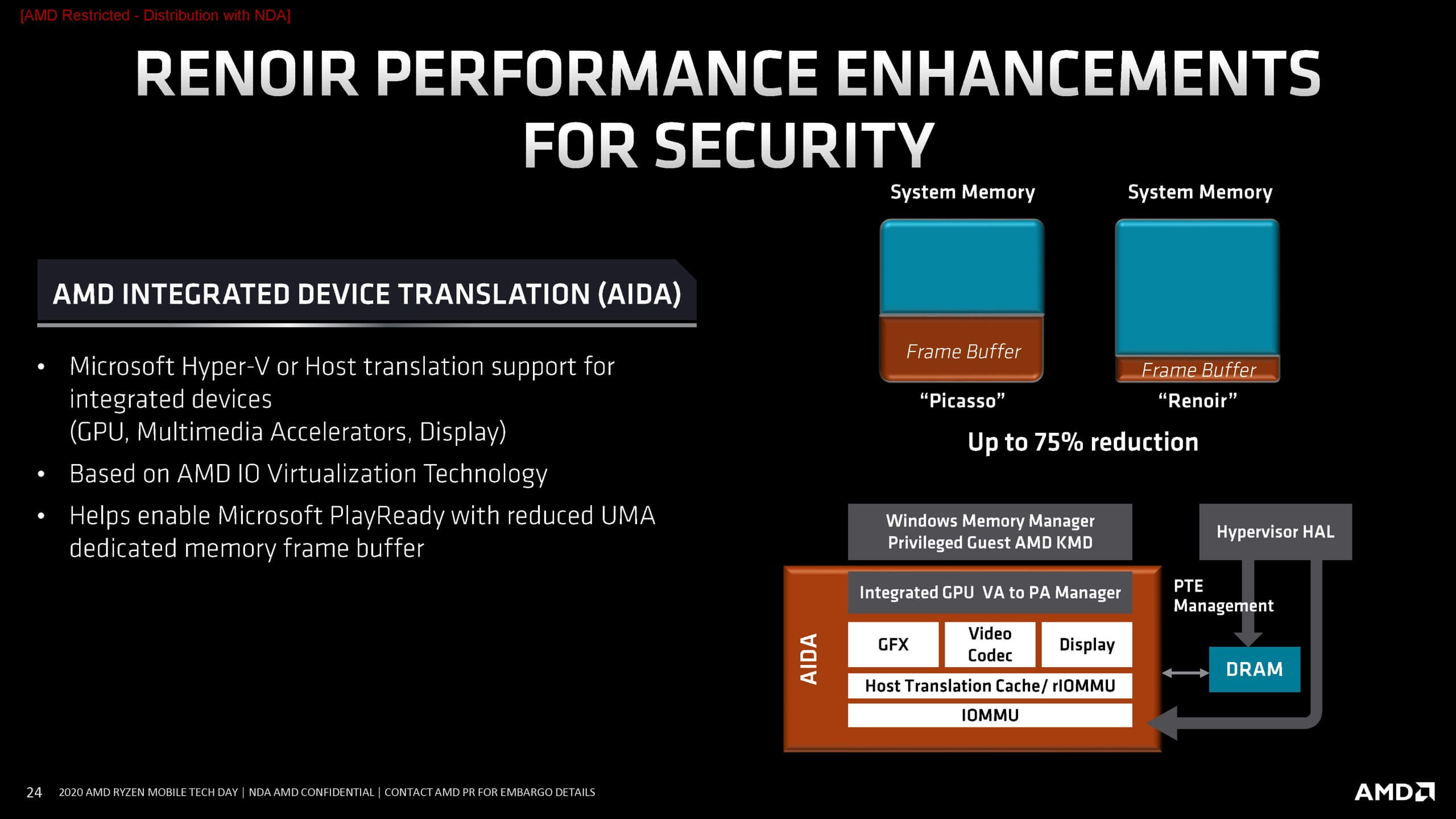
Power is also a big question mark with Ryzen 4000, given this wasn't a strong suit of AMD's last generation products. AMD says that Ryzen 4000 APUs, thanks to Zen 2, deliver twice the amount of instructions per unit of energy, in other words they're twice as efficient. 47% of that is attributed to the shift to 7nm, another 15% on IPC and the remaining 17% on the design.
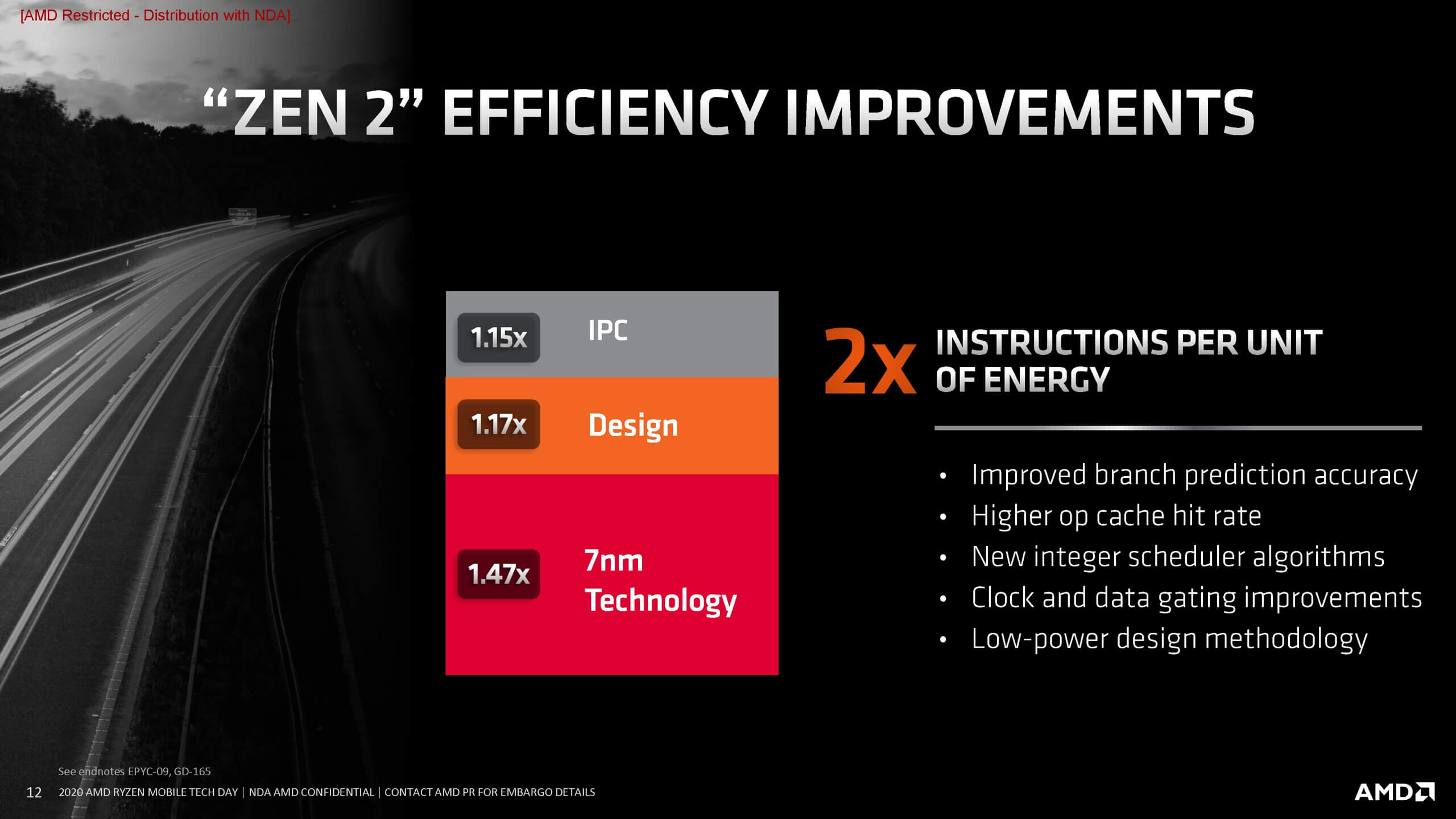
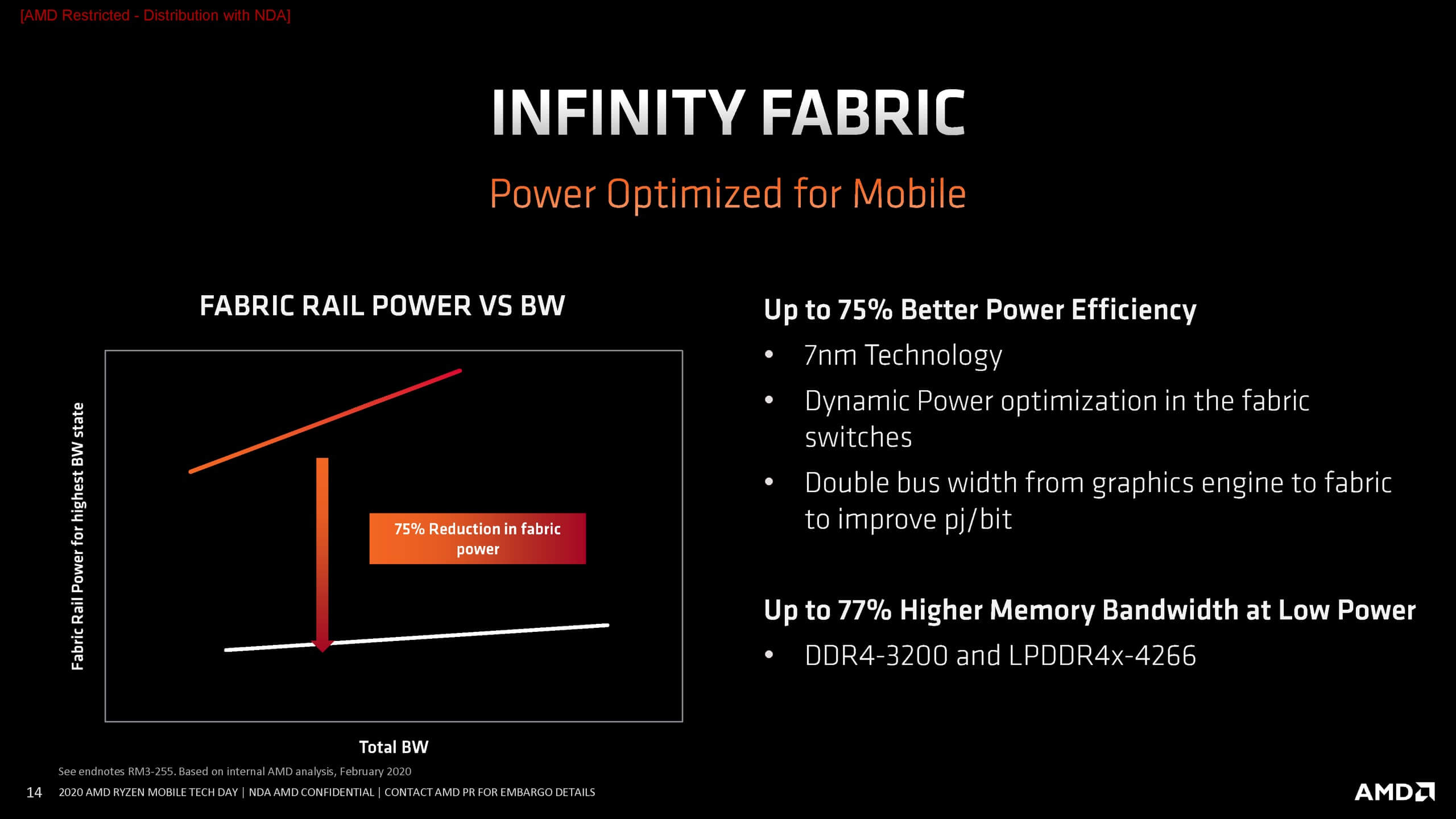
AMD also touts other power consumption gains. The infinity fabric now delivers up to 75% better power efficiency thanks to optimization in the fabric. The shift to new, faster memory also improves performance without affecting efficiency in a significant way. On top of that, AMD has been able to reduce SoC power by 20%. In other words, we're getting higher levels of performance within the same power envelope, but AMD is also hitting lower SoC power when performance isn't needed.
Many improvements to power consumption will come from Ryzen 4000's ability to manage clock speeds better. These APUs are able to boost up to high frequencies and drop down to lower clock speeds more quickly, and then maintain those low clocks for longer. In one case with PCMark 10's app start benchmark, AMD reported 59% lower power consumption during the execution phase.
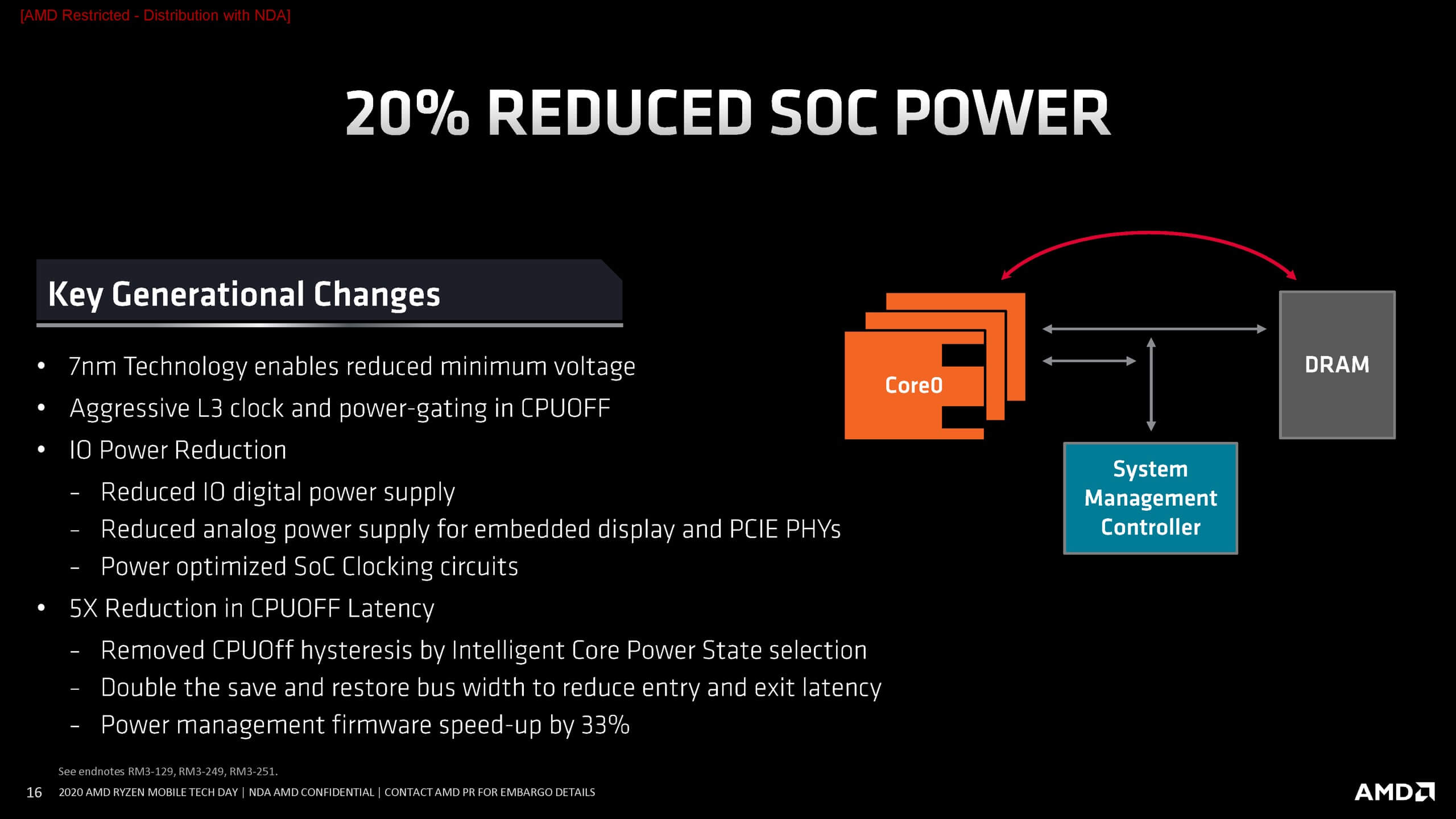
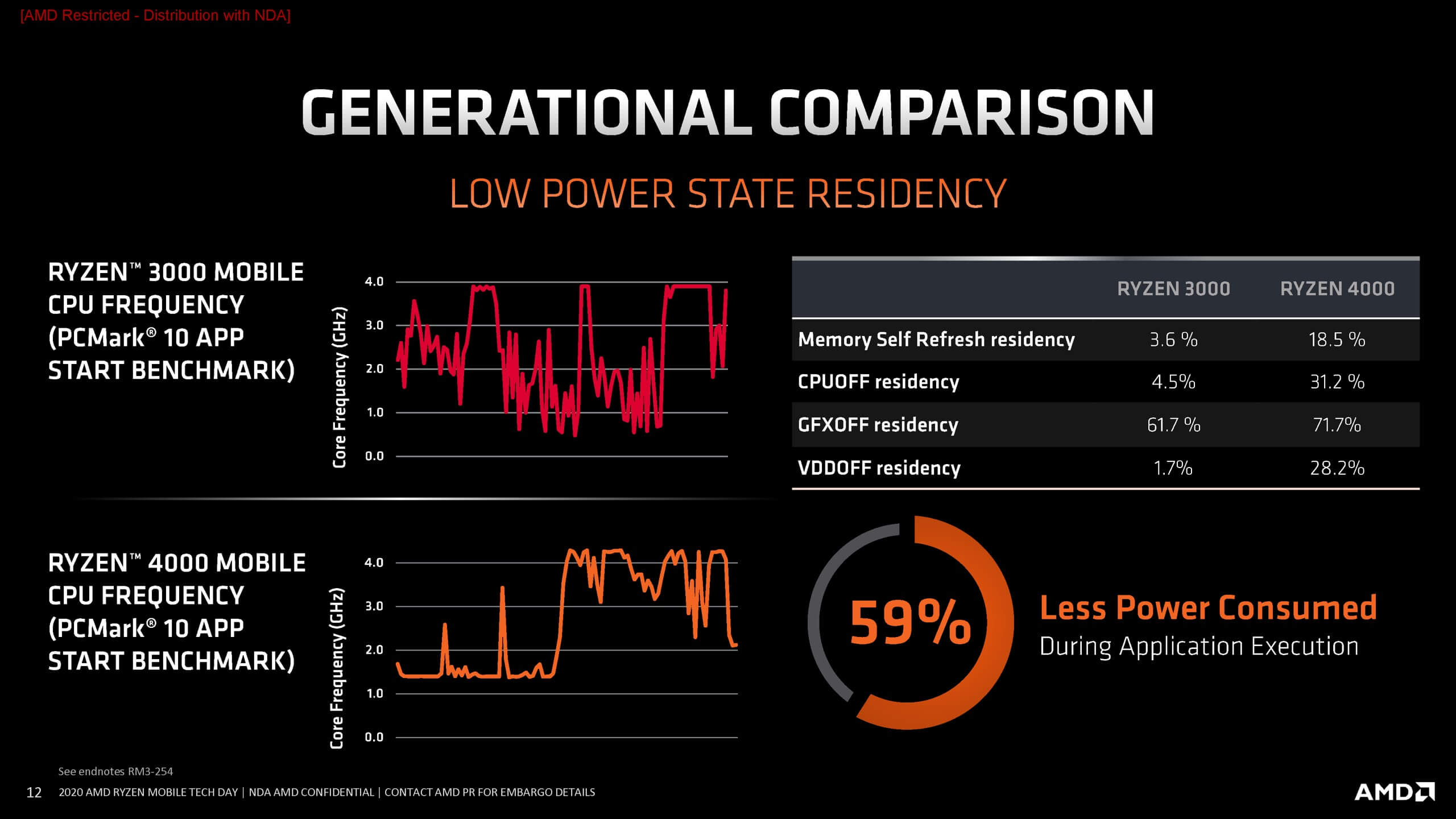
AMD broke down the battery life they achieved in their testing with the Ryzen 7 4800U in the Lenovo Yoga Slim 7 and compared it to the Dell XPS 13 with Intel's latest chip, the Ice Lake Core i7-1065G7. There was a lot of lead-up to this part but here are the numbers, and we'll focus on the normalized Dell numbers here.
The 4800U in AMD's numbers delivered better battery life for light productivity and gaming, as well as similar battery life for video playback. However it fell behind in heavy core activity as well as low power idle states. This seems to be a fairly honest look at what to expect with Ryzen 4000, again we'll have to test it but the results certainly are interesting. AMD even joked that Intel CPUs are "great at doing nothing" when describing the discrepancy between Ryzen and Ice Lake's idle battery life, where Ryzen still seems to be less efficient. Overall though, through some funky maths and "blending" it all together, AMD expects system battery life to be similar to their Intel counterparts.
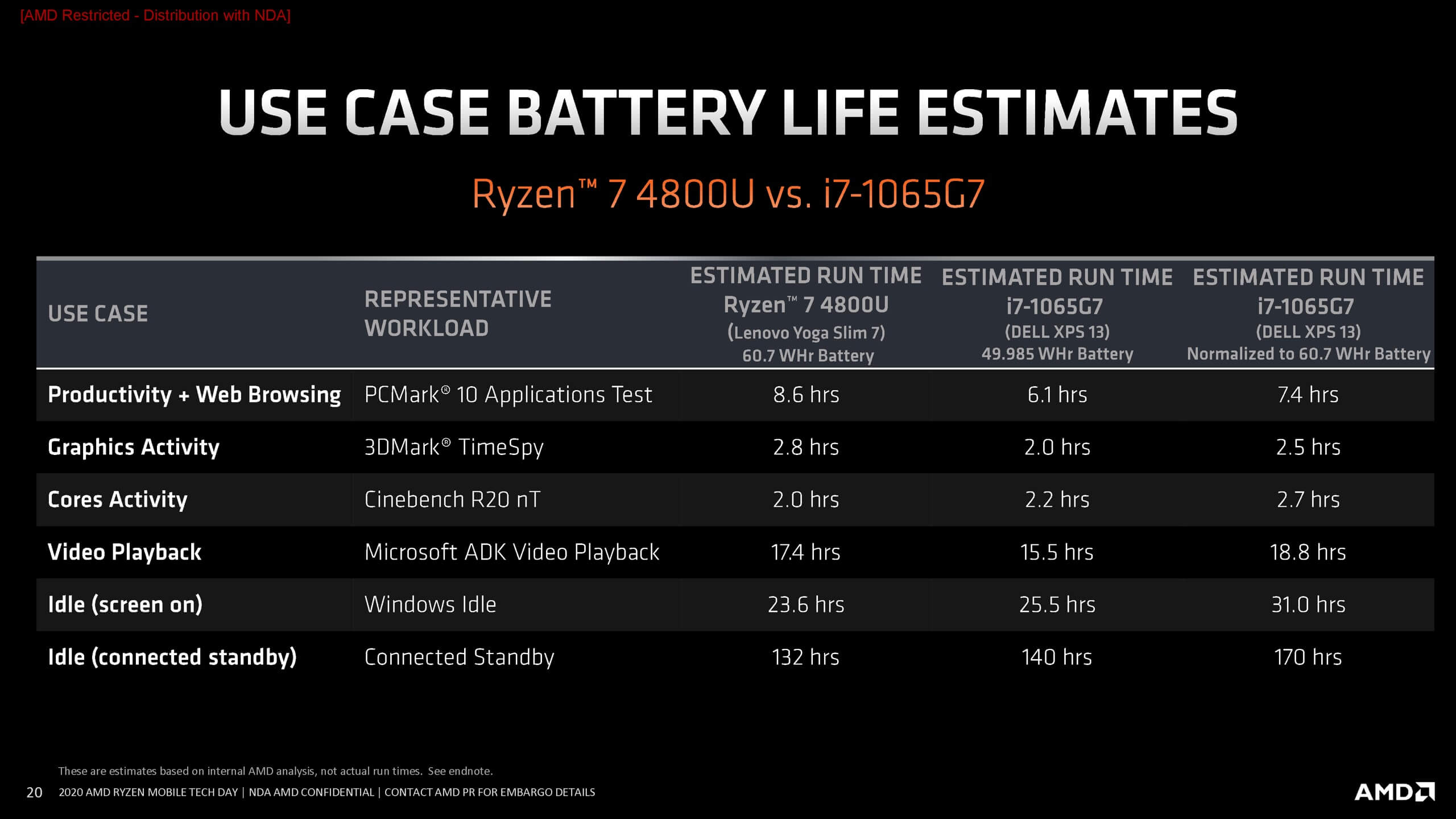
A few other quick tidbits
Ryzen 4000 APUs integrate a new multimedia engine with a 31% faster encoder and support for new formats, including 4K60 decoding of VP9 and 4K60 encoding of HEVC.
AMD also described a new featured called Skin Temperature Tracking V2, or STT V2, that allows better measuring of the surface temperatures of a mobile device. This is then fed back into the APU and used for boost management. The result is a Ryzen 4000 APU that can boost for longer when the outer surface of the laptop is cooler, for example if it hasn't been heavily utilized just prior to the workload being run.
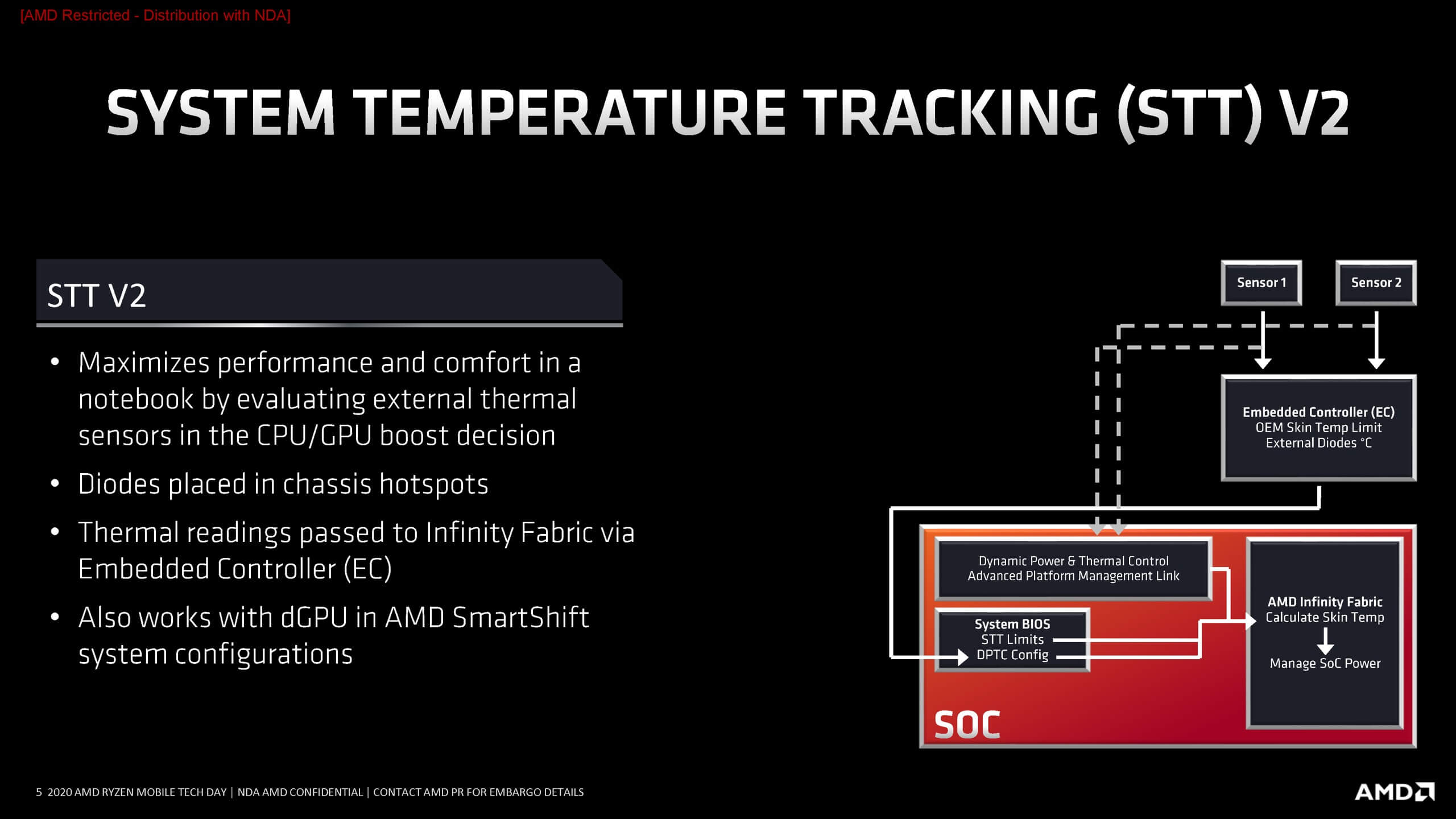
AMD showed a demo where this feature substantially increased performance in the first few minutes of a high intensity workload, as it essentially just holds boost clocks and a higher power limit for longer. Intel introduced something similar to their mobile chips in the latest generation, called Adaptix.
And that's all we can share for now. Hopefully we'll be able to bring you some real world benchmarks in the next few weeks, with systems coming soon and performance looking impressive. Everything that we've seen so far suggests this will be a single APU solution for both high performance productivity and solid GPU performance, something Intel currently offers in two separate line-ups (Comet Lake for productivity and Ice Lake for GPU). It's poised to make AMD competitive in this space for the first time in a long time.
